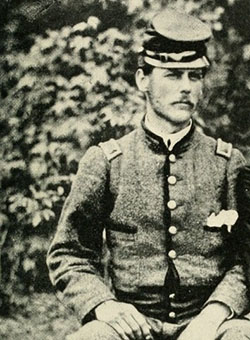
Please send all Checks and Money orders to :
Dave Taylor P.O. Box 87 Sylvania, OH 43560
419-842-1863
Click Here to E-mail Us!
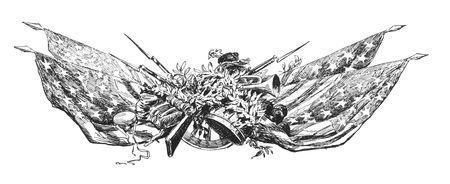

14 09
~~~~~~~~~~~
LAYAWAYS ARE WELCOME:
Need to split your order into multiple payments? No problem! A simple 20% earnest money deposit will hold your item for you.
You can then pay it off in easy installments that fit your budget.
~~~~~~~~~~

14-09-01 … 1859 Dated Austrian Lorenz Jaeger Short Rifle …
Also known as the Jaeger or Yager rifle, this is .54 caliber with an octagon barrel turned round for the last 4.25 inches. Over 7,000 of these guns were imported for use in the Civil War, mostly through the firm of Herman Boker. They took a saber bayonet with a spiral grooved socket for the sight and stud, have a distinctive curved rear sight and trigger guard with hand rail. Iron mounted, the barrel fastens to the stock with wedges. The stocks were drilled and equipped with a thimble for the ramrod for US army use, (Austrians carried their rods on a sling). Some have cheek rest, others like ours do not. Nice wood with very few handling marks, minor age cracks at upper side plate. Metal smooth, silvery gray with darker gray and brown areas. Some pitting to the butt plate, and a bit of roughness near the muzzle. There is a small rectangular notch on the left side of the barrel flat just behind the rear sight. European inspector and unit markings, 859 lockplate marking indicates an 1859 manufacture. The rear sling swivel is in place, but the upper swivel is missing. Rear sight is missing the wing nut or thumbscrew on the end. This is one of the scarcer Civil War import rifles, bordering on rare… many times rarer than the Austrian Lorenz infantry rifles …
$1,350.00 SOLD
vgjjx
Click Here to E-mail Us!
Call us @ 419-842-1863

14-09-02 … Super Brass Mounted 1859 Sharps Carbine with Cartouches …
An early New Model 1859 Sharps with brass furniture and brass patch box! Since the numbering started at about 30,000, our serial number of 31921 is very early. One of the most recognizable Civil War carbines, the Sharps was popular, well regarded and widely issued. The brass mounted model 1859 is a scarcity in any condition and downright rare when found this nice. It is considered among the most attractive US martial arms, both then for soldiers and now for collectors. A great many went South and were used by Confederate cavalry. I have one in my collection inscribed as being captured by an Iowa officer early in the war. Ours still has loads of color on the barrel, a deep plum with shades of brown underneath. The casehardened receiver shows a mottled silver and gray aft and a tad darker forward. Both sights are in place, including ladder on rear sight. Sling bar and sling ring are also in place. Brass butt plate, patch box and barrel band look are a nice yellow color. Crisp Sharps barrel markings and Lawrence sight marks. Crisp Sharps receiver markings on both sides. Wood is excellent with two very visible crisp cartouches at the wrist above and below the sling bar. Cartouches are WAT and JT. Superb wood to metal fit, mechanically perfect, excellent bore. Crisp! You will look long and hard to find another as nice. The quintessential US Cavalry weapon of the Civil War, and pretty to boot!
… $4,650.00 SOLD
ychjjx
Click Here to E-mail Us!
Call us @ 419-842-1863
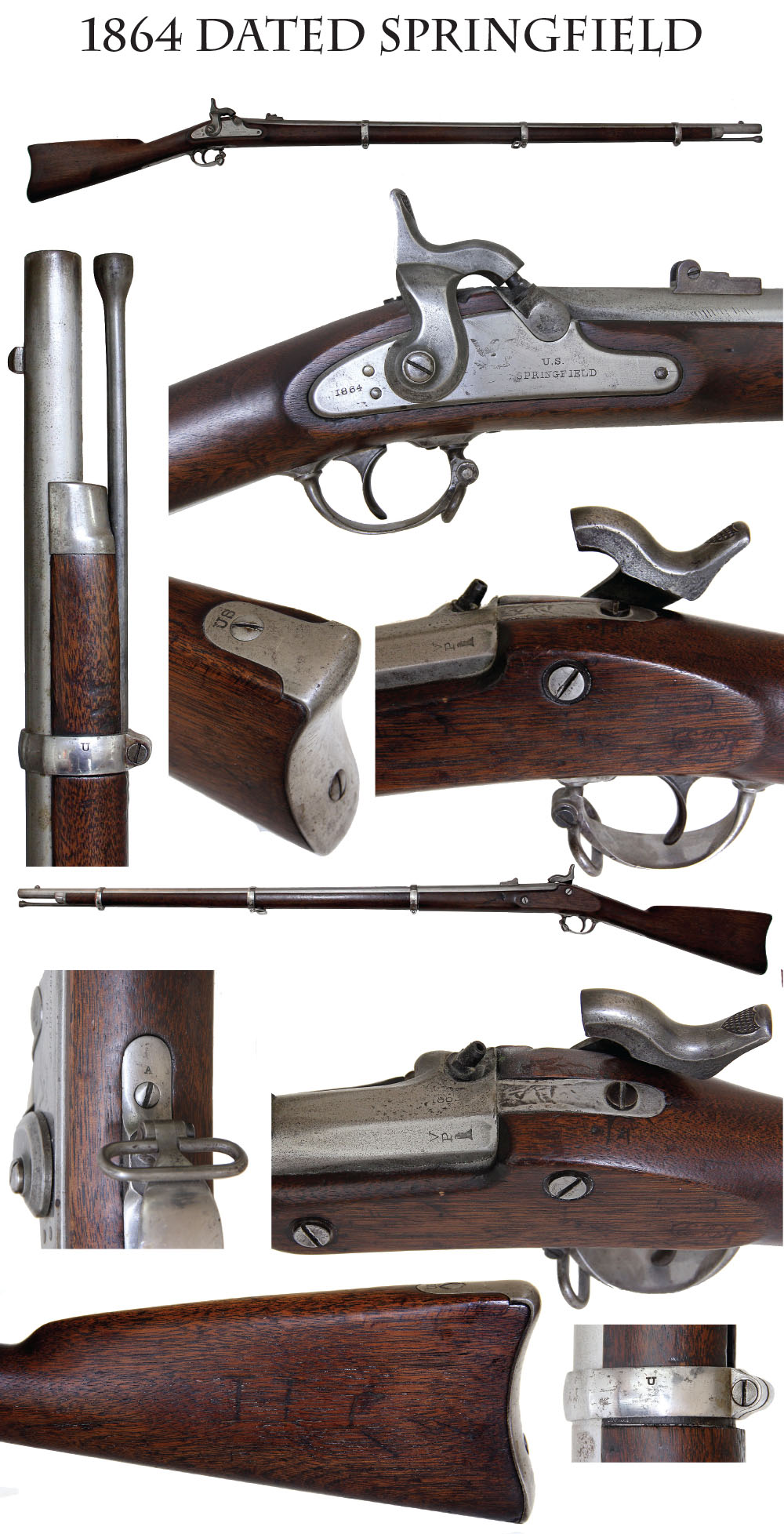
14-09-03 … 14-07-04 … Near Fine Condition Springfield 1863 Rifle Musket Type I :
These 1863 pattern Springfields modified the 1861 pattern in a number of ways. The most obvious is the use of a beveled hammer (thank you Samuel Colt) and the elimination of retaining band springs by using rounded contour screw-fastened clamping bands. This last innovation quickly proved to be a problem when recoil energy in firing jolted the bands loose. In short order the Model 1863 – Type II (a.k.a.1864) pattern reintroduced the retaining springs which were kept on Springfield rifles all the way up through the M-1 Garand of WW2 and Korea. Bright steel overall, with some original bright finish and some cleaned areas. Clear lock plate marking of 1864 rear of the hammer and U.S. over Springfield forward of the hammer with just some scattered graying on the hammer from the casehardening. The Springfield eagle with shield appears on the bolster and just to the right of hammer, being a little soft in areas. Very nice wood, with a set of lightly carved initials on the offside of the butt, still showing very evident ink inspector cartouches on the wood opposite the lock including the mandatory Springfield “ESA”. The wood still has strong and just slight rounding from handling on the forward edge. Good wood-to-metal fit overall. Sharp US on butt plate tang, directional “U”s on bands, swivels and correct rod in place. Correct mid war rear sight and leaves; front sight firmly in place. Clear V/P/eagle barrel proofs at left breech. Barrel date is clear, a bit light on the last digit which is a “3” showing the barrel was made in late 1863 and assembled with a lock made in early 1864 – all completely correct. The breech plug tang shows a little bit of buggering along the edges and there is a very light vise clamp mark just under the rear sight on the offside, but this is not very noticeable. Fine bore. An extra nice example of the classic Civil War infantry arm and one looking a lot like it did when it came out of the crate
… $1,795.00
SOLD
Click Here to E-mail Us!
Call us @ 419-842-1863
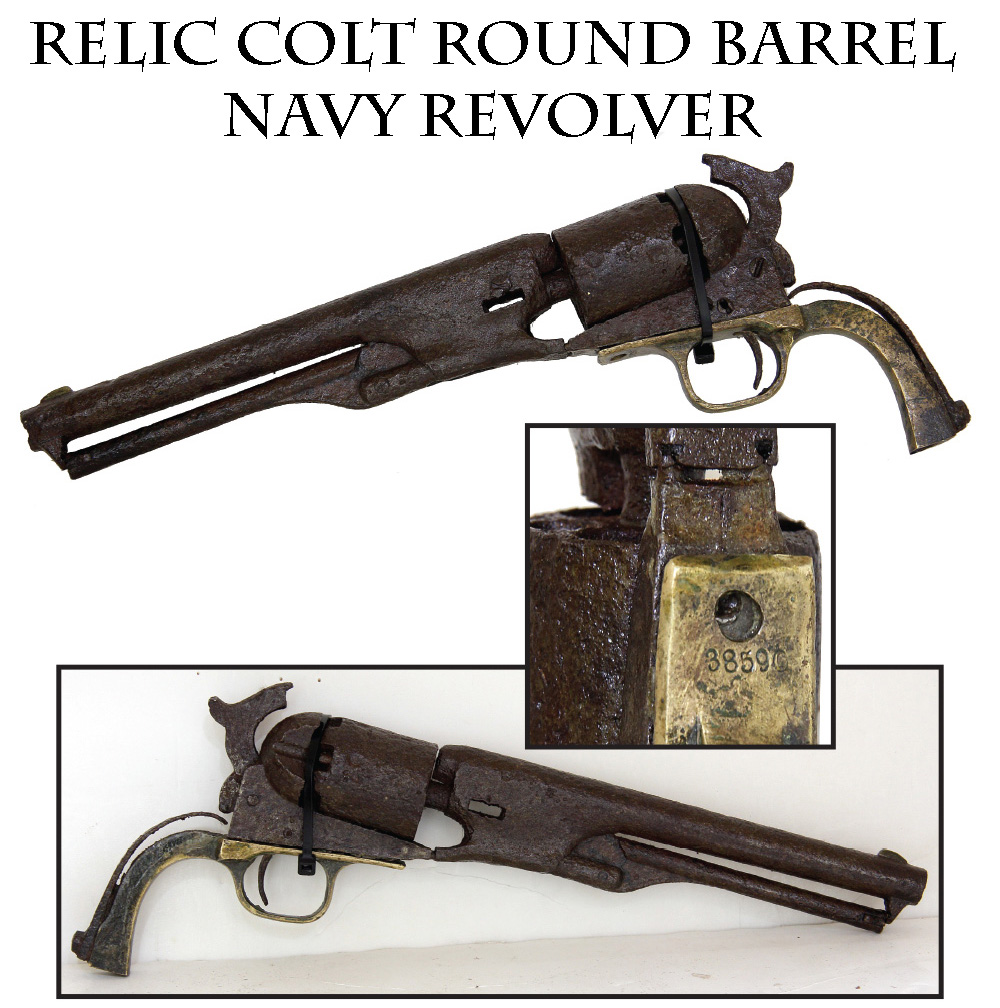
14-09-04 … Rare Battlefield Found Model 1861 Colt Round Barrel Navy: …
A very cool cavalry relic – a .36 Colt round barrel navy revolver just as it was dropped by some trooper 150 years ago. The loading lever is in place, hammer partially cocked – making one wonder if the soldier was killed in battle as he tried to cock the gun to defend himself … grips, back strap, wedge and some screws missing, but what a great rustic look! The trigger guard screws are completely corroded so we have a plastic electrical tie holding the trigger guard to the frame. You can secure it better yourself with a thin wire which will display better. Finding a near complete revolver with a metal detector is about 100 times rarer than finding a Confederate buckle. Has very clear serial number 38590
… $595.00
Click Here to E-mail Us!
Call us @ 419-842-1863
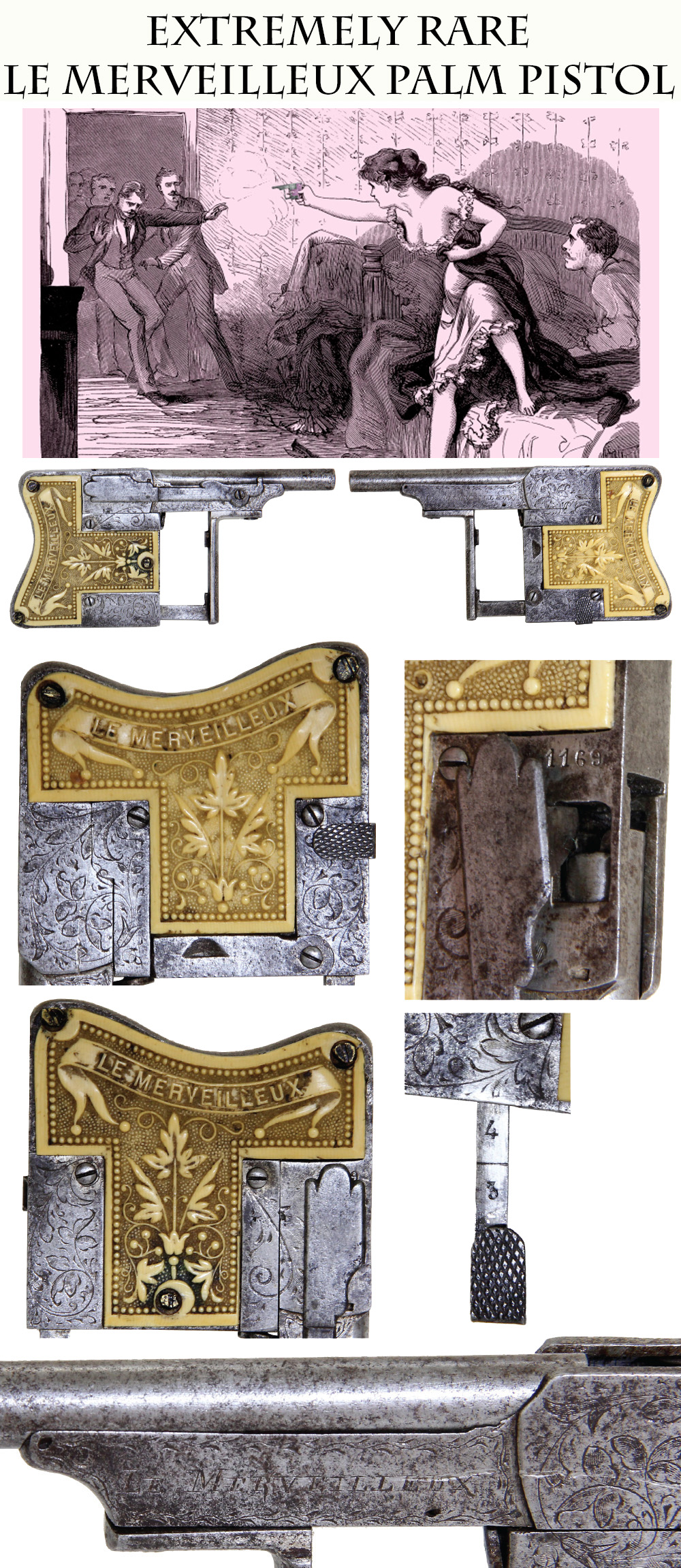
14-09-05 … Exceedingly Rare Deluxe Grade Le Merveilleux “Squeeze Fire” Palm Pistol! …
These 1880 era diminutive French 6mm pocket pistols are functional small works of art, and a true curiosa. They were made in common grades with hard rubber grips and in deluxe grades using top end materials like this one. The barrel is a mere 2 ¾ inches, round and unmarked. The frame is hand engraved overall with floral motifs and is inlet on either side for T-shaped flat factory relief carved grip panels that are raised carved on a raised dot background with the pistol name (Le Merveilleux = “The Marvel” or the “The Wonder”) in a thin banner across the back edge with a blossoming plant beneath, framed with raised dots. No doubt the buyer of this would “marvel” at the absolute “wonder”fully exquisite workmanship and quality. The metal is smooth gun metal grey and the grip panels are extremely nice, no chipping and a pleasing mellow patina with just enough dirt in some of the crevasses to enhance and highlight the antique patina. The pistol is small enough to fit in the palm of the hand and is fired by squeezing the front part of the grip, which acts as the trigger. Significant makings in addition to the artistic work includes a serial number behind the loading flap, two other numbers that may be assembly numbers on a pull slide on the bottom left of the handle, and the pistol name engraved in the metal receiver just under the barrel. Just the thing for a night out at the opera, Folies Bergere, or the Absinthe bar. A refinished example sold April 30th 2010 for $3,585.00 at Rock Island Auction. I wager you will not see another for sale this year, especially priced this friendly
… $2,450.00
Click Here to E-mail Us!
Call us @ 419-842-1863
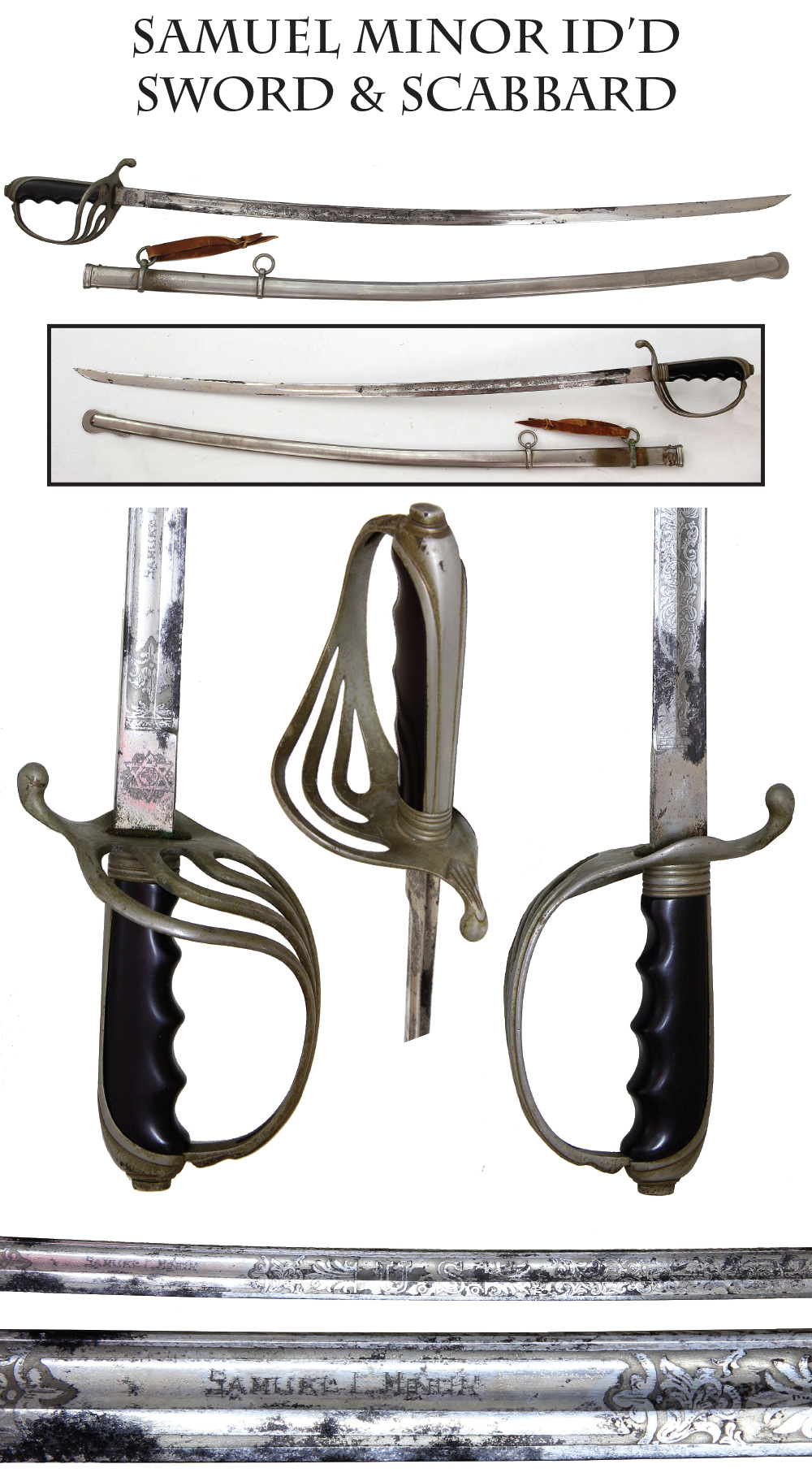
14-09-06 … Samuel L. Minor ID’d sword and scabbard …
Identified 1902 Pattern U.S. Officer’s Sword … this was the last regulation pattern for US officers: steel mounted, slightly curved, single edged with a false back edge, simple pommel cap, three branch guard, and steel scabbard. Blade etched with floral sprays and military trophies with a large US on one side and an eagle on the other. Regulations called for it to be finished in “dull finish nickel,” which resulted in splotchy gray areas as the finish gets worn – and our example here is no exception to that. In this case, the officer went to the extra length of having his name engraved in thin block letters in a panel to the left of the US: “Samuel L. Minor.” Some research might pay off with an interesting service record. This is the standard US officer’s sword of World War 1
… $175.00
SOLD
Click Here to E-mail Us!
Call us @ 419-842-1863

14-09-07 … Fine Hartford Made Colt Navy with London Barrel Legend:
One of the more pleasing Colt Navies I have owned. What makes this one so interesting is that it is a US made revolver that utilizes Colt London parts… made in 1857 after Colt gave up his English endeavors and shipped all the machinery and parts from his London factory back to his main factory in Hartford, CT. The parts were intended for the London market, but when English sales did not meet expectations the parts were shipped home and used here. Note that there are absolutely no English proof marks whatsoever. All English used guns bear the British proofs. This revolver was assembled here in the USA and sold here. Of note – I once owned a martial US Navy-Navy completely US inspected which utilized a London marked barrel. It bore a serial number in the Hartford range. Colt did not throw away the English made parts, he used them back here in the states. Our gun has matching London range serial number throughout: 38455, (1857 date of manufacture). Crisp “Address Col. Colt London” barrel stamping and very visible Mexican War naval battle scene on the cylinder. The metal is smooth, showing traces of plum mixed with gray. Edges are sharp. Grips are very good with the exception of a small chip on the inboard toe. The collection number in white paint on the butt strap is Don Troiani’s inventory number, this gun having been part of his collection for many years until we did a huge trade earlier this year. …- easily cleaned off if you wanted to, but I elect to leave it. Sight in place, nipples are not battered, mechanically perfect. A dandy
… $1,950.00 SOLD
Click Here to E-mail Us!
Call us @ 419-842-1863

14-09-08 … Identified Civil War Soldier’s and Indian War Officer’s Pocket Pistol …
These .22 caliber single shot Frank Wesson pistols were good for target practice and parlor shooting, but also made an easily concealed weapon of personal defense. The barrel tips up for loading by pulling back the small lever under the barrel. This is particular one is the Type 2, made starting in 1862, as indicated by the patent dates on top of the barrel. Professionally engraved in script on the brass backstrap is “T.D. Shepherd” and on the buttstrap next to the stamped serial number 9317 is engraved “11th USA.”
Thomas Daniel Shepherd was from Illinois and served in Co. K, 70th Illinois Infantry, a three-month unit, from 6/9/62 to 10/23/62, being promoted to corporal and then sergeant. He enlisted again 4/26/64, in Co. K 9th Indiana Cavalry, serving until 6/15/65. The regiment operated primarily in Tennessee and Alabama against Forrest and Wheeler, losing 4 officers and 28 men killed and mortally wounded, which is fairly heavy for a cavalry outfit. Shepherd must have liked the army life. He signed up once more, this time taking a commission in the regular army, mustering in as 2nd Lieutenant 11th US Infantry 3/5/66 and making 1st Lt. 1/22/67. He resigned 6/19/68. The pistol obviously dates to his service in this period, likely kept as “walking out” pocket pistol. He resigned from the army 6/19/68 and died 2/13/17. He has a pension application card on file, so there might be some interesting details to be gained from his records … ab
… $1,395.00 SOLD
Click Here to E-mail Us!
Call us @ 419-842-1863

14-08-09 … H.A. Dingee Marked Eagle Breastplate …
These round eagle breastplates were introduced in the 1820s for the bayonet cross belt, and were retained for use on the cartridge box sling. This one is a nice attic condition example with a mellow patina, some minor spotting, and a few dings that would be expected on a piece like this, but nothing detrimental. Both loops are in place on the back. Ours also shows most of the contractor’s stamp of H.A. Dingee, with just a tad light on the beginning of the last name. Maker Henry A. Dingee was the son of Robert and brother of Robert, Jr. The family was engaged in the manufacture of leather gear and military accouterments from early in the 1800s. By the Civil War Henry was running the firm on his own and had many contracts for equipment from the government both on his own and with George T. Lorigan. Dingee specialized in leather gear and it is thought he subcontracted the belt and box plates but had them marked with his name to go with the accouterment sets he was supplying. One of the scarcer markings to find. A nice example of a key Civil War accouterment plate with many variations for the collector
… $275.00 SOLD
Click Here to E-mail Us!
Call us @ 419-842-1863
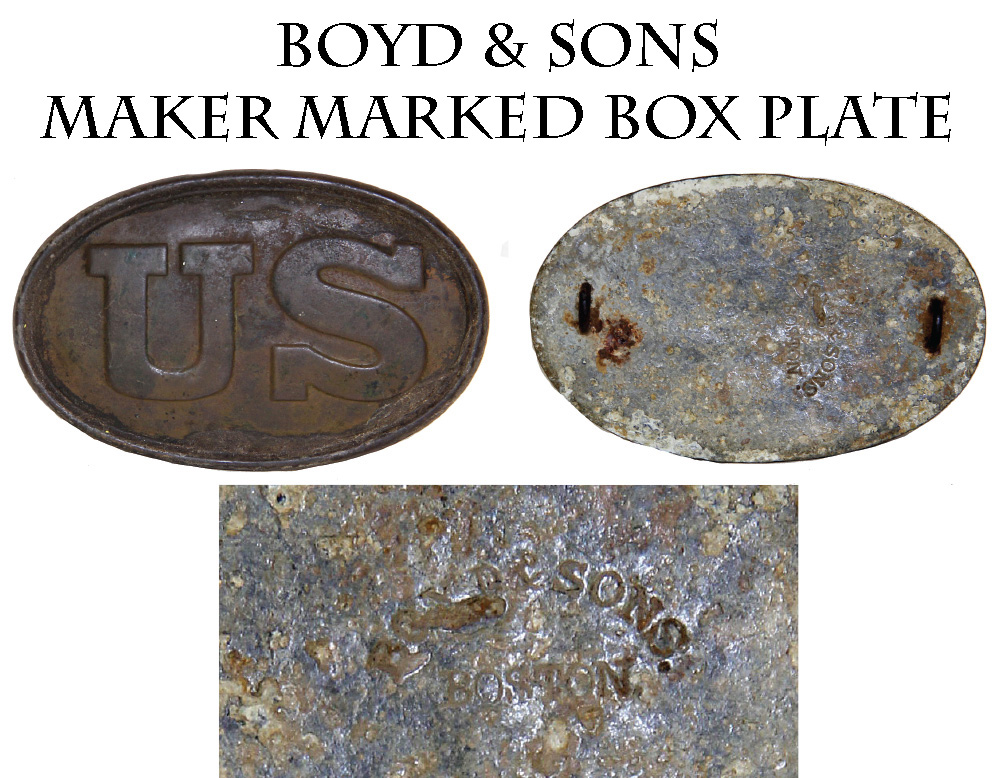
14-08-10 … Battlefield Dug-Up Boyd & Sons Contractor Marked Cartridge Box Plate …
A good condition excavated example of the regulation Civil War cartridge box plate, an oval US stamped brass plate, lead solder filled back with two intact iron loops to be secured to the cartridge box flap both as an ornament and to keep the flap down when the latch tab was unfastened in action. Chocolate brown and reddish patina, the back shows some oxidation as usual. A nice Boyd & Sons / Boston stamp is clearly stamped into the lead, just a tad light on the first part of the name but remains very legible. The Boyd firm was in business from the early 1800s and had numerous Federal and state contracts through the Civil War. Like other accouterment makers he probably subcontracted the plates for his gear but had them marked with his firm name. Another example of an accouterment plate that is a subcategory of Civil War collecting in itself
… $265.00 SOLD
Click Here to E-mail Us!
Call us @ 419-842-1863

14-09-11 … Extra Fine Condition Remington-Elliot 4 Shot Pepperbox …
A top notch example with 60% original bright factory blue finish still present. NRA “fine” condition. 100% original, 100% complete, and mechanically perfect. Playing cards in the 1860s or 1870s … Suspect the fellow across the table is dealing from the bottom of the deck? Our little friend will give him the belly ache sure enough. This .32 rimfire Remington-Elliot is popularly known as a “pepperbox,” though Remington called it the “New Repeating Pistol Elliot’s Pat. No. 2.” The ring trigger is easy to fire, but not easily fired accidentally. It features four barrels 3 3/8 inches in length, fired in sequence by a rotating firing pin. Super grips and Super high finish on the steel with a little brown coming up on the underside of the barrels and the frame. Remington maker’s marks on the left barrel frame and Elliot patent markings on the right are sharp and legible. Serial numbers (11253) are matching, and found under the barrel and inside the slide chamber. Perfect for Civil War or early western display with production starting in 1863 and running into the Wild West era
… $1,050.00 SOLD
yheju
Click Here to E-mail Us!
Call us @ 419-842-1863
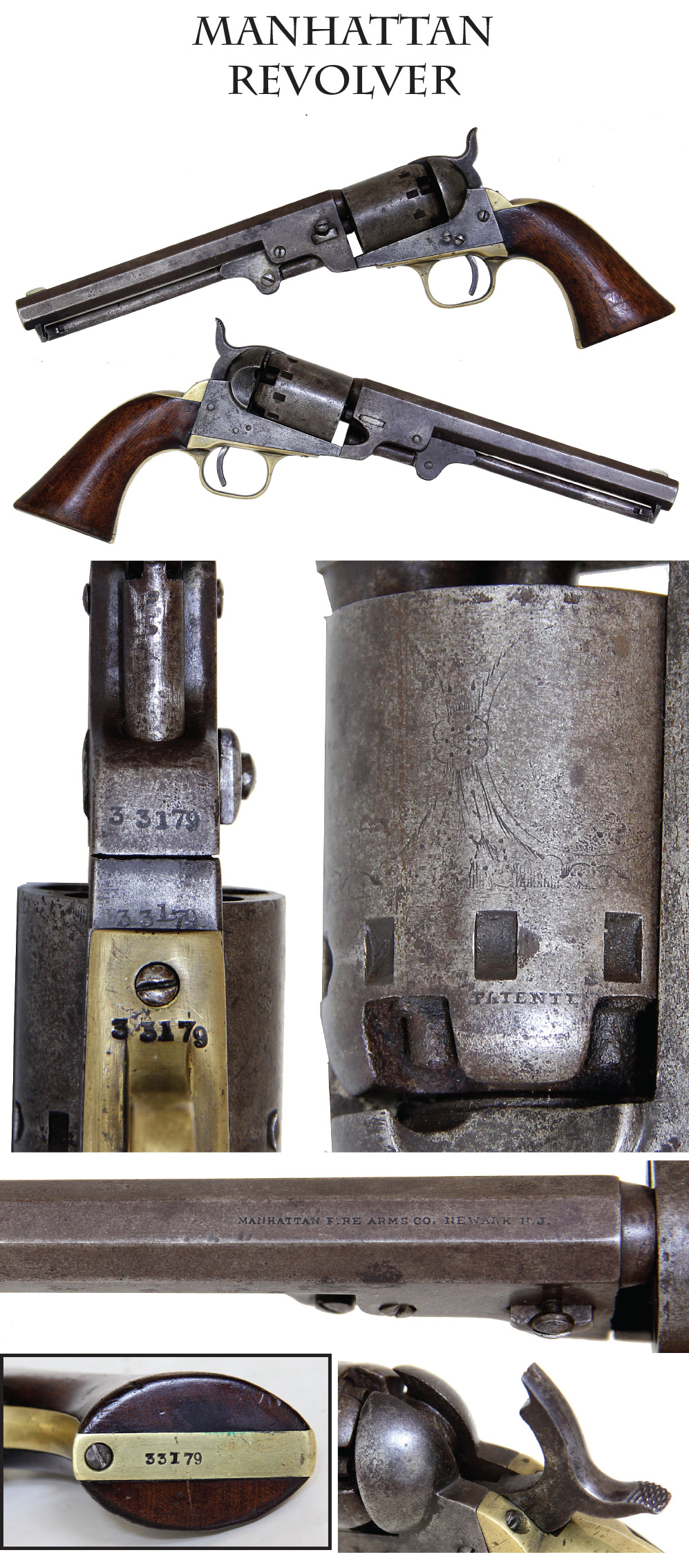
14-09-12 Manhattan Firearms .36 Caliber Navy Revolver …
A highly popular 1860s commercial revolver carried by innumerable Civil War soldiers. The five-shot Manhattan was patterned after the Colt Navy and Colt 1849 Pocket revolvers. The cylinder bears the patent date and is roll engraved with oval panels bearing military and naval scenes, the panels are visible but the scenes are now rather light. Sharp single line barrel address and matching serial numbers 33179. Traces of case colors showing as faint purple, gray and plum brown mixed with silver overall. Grips very good, two dings low down on the inboard side near the butt, but nothing significant and no chipping or losses. Tight wood to metal fit, sight, wedge, and loading assembly in place. Nipples showing some wear, but not battered. Good color to brass, screw slots not buggered. This piece was well maintained and used. The Manhattan Firearms company was formed in 1856 and when Colt’s patents began expiring in 1857 they capitalized on the opportunity and produced this popular revolver. In collector parlance, this belongs to their Series III. it is truly a nice gun …
$950.00 SOLD
Click Here to E-mail Us!
Call us @ 419-842-1863
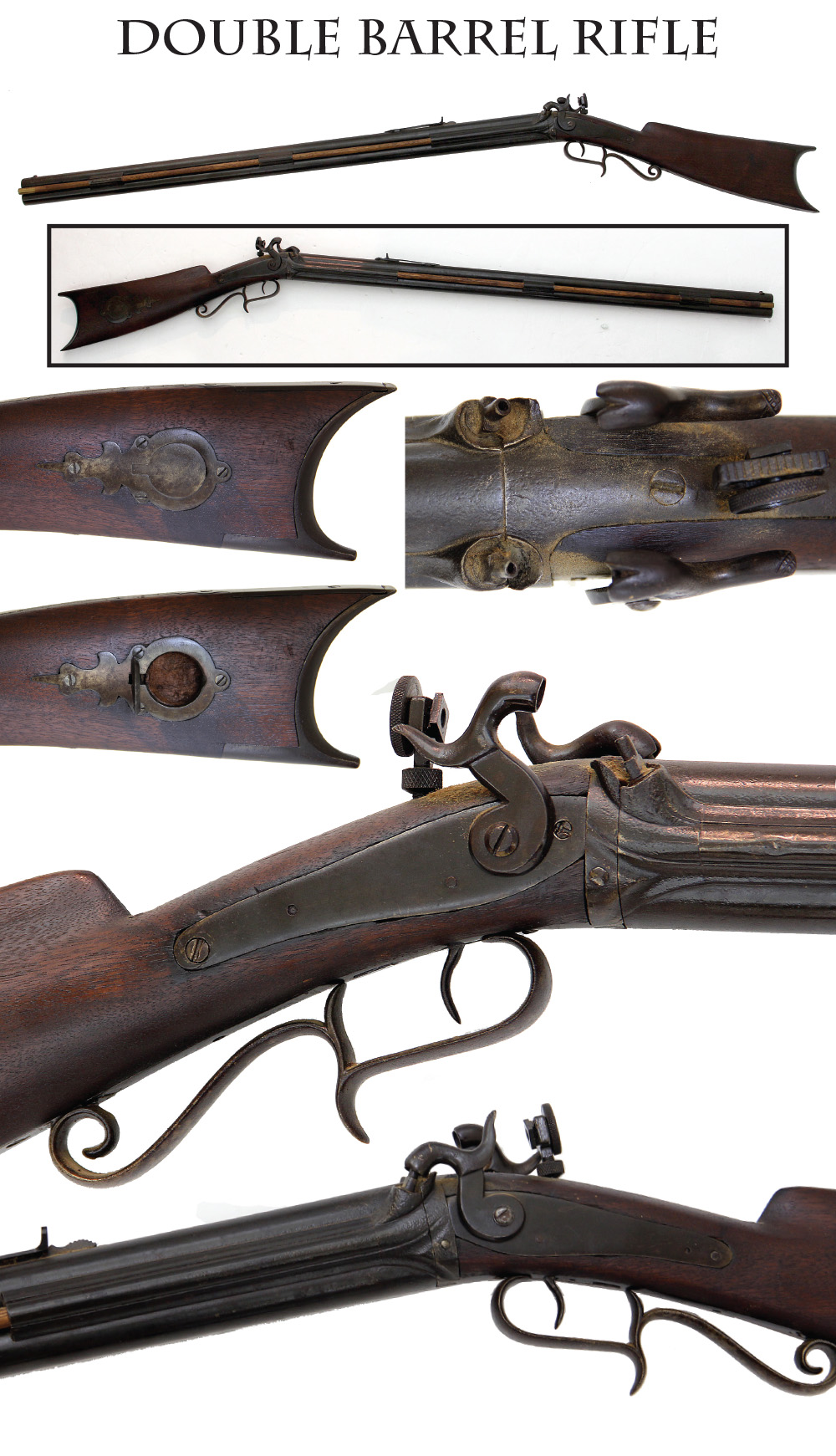
14-09-13 … Over and Under Double Barrel Percussion Rifle …
A pleasing 1850s frontier style double rifle. Back-action locks and double hammers give it that extra look of intimidation to go with its hefty weight. The nipples are dirty but not battered down and the wood offers a nice medium brown tone only minor handling marks. A round brass patchbox, butt plate and scrolled trigger guard give the overall look a little extra flair as well. Front and rear barrel mounted sights, and peep sight mounted on the breechplug tang are all present, as are the ramrod thimbles on either side between the barrels. The thimbles capture two brass-capped wood rods. This needs a small bit of basement gunsmithing … the rear trigger is missing so the right hammer is stuck at the cocked position. The forward trigger is fine and te left action functions. Some slight corrosion is present on the breech from firing, and I believe the left hammer screw is an old replacement … otherwise the metal is smooth, with a pleasant barrel browning and age brown mix. A nice look overall and not a tough repair
… $1,350.00
Click Here to E-mail Us!
Call us @ 419-842-1863

14-09-14 … Double Set Trigger Berdan Sharps Rifle #54511 …
The “holy grail” in Civil War Sharps collecting: a genuine Berdan Model 1859 Sharps Rifle with double set triggers in the proper serial number range. Hiram Berdan ordered 2,000 of these Sharps rifles for his sharpshooters – breech loading for speed and specially equipped with double set triggers for accuracy- one trigger sets the other as a hair-trigger so the trigger pull does not disturb the aim. Berdan rifles fall roughly in the range of high 53000s to low 58000s. Ours is 54511. Note: Some years ago I found a Berdan’s company records book that re-set the known high and low numbers reported by Marcot and Flayderman. If you have a rifle, I’ll be happy to check my numbers for you. This rifle has certainly seen use in the field, as have just about all real Berdans. All the metal was cleaned at some point, leaving scattered gray areas. This is now toning down to a better cooler tone of silvery gray. The wood likewise was cleaned to a lighter brown with darker brown stains. We believe these two factors are significant as the “JT” stock cartouche is nearly completely worn away. A faint rectangle is visible under light with magnification. And the sub inspector’s initial at the breech is likewise nearly completely gone. Both the result of long ago cleaning. Some small shrinkage gaps here and there and a chip out along the top edge of the barrel channel on the right of the forestock from the breech are mentioned for accuracy, but are fairly common and not detrimental to the overall appearance.
The mechanics are good, sling swivels in place, patchbox is functional, and the rear sight is in place. Like the other Berdan example we sold a couple months ago, this too has the 800 yard rear sight as opposed to the 1000 yard sights found on regular Sharps rifles. The marks are what you’d expect … very legible Sharps patent markings on left and right of receiver, New Model 1859 marks at barrel breech, slightly rubbed Sharps manufacturing marks forward of sight, but legible, Lawrence sight patent marks, and clear serial number on tang. The bottom line: not many Civil War weapons can be associated with a specific unit, and far fewer to a unit as elite and as famous as Berdan’s Sharpshooters. They were clothed in green, issued special weapons and equipment, and they served in the Army of the Potomac in all the major campaigns – including Gettysburg, where they were particularly engaged on July 2. This is a dead-real Berdan Sharps that you know was really there … gjjj/grcia
… $7,950.00
Click Here to E-mail Us!
Call us @ 419-842-1863
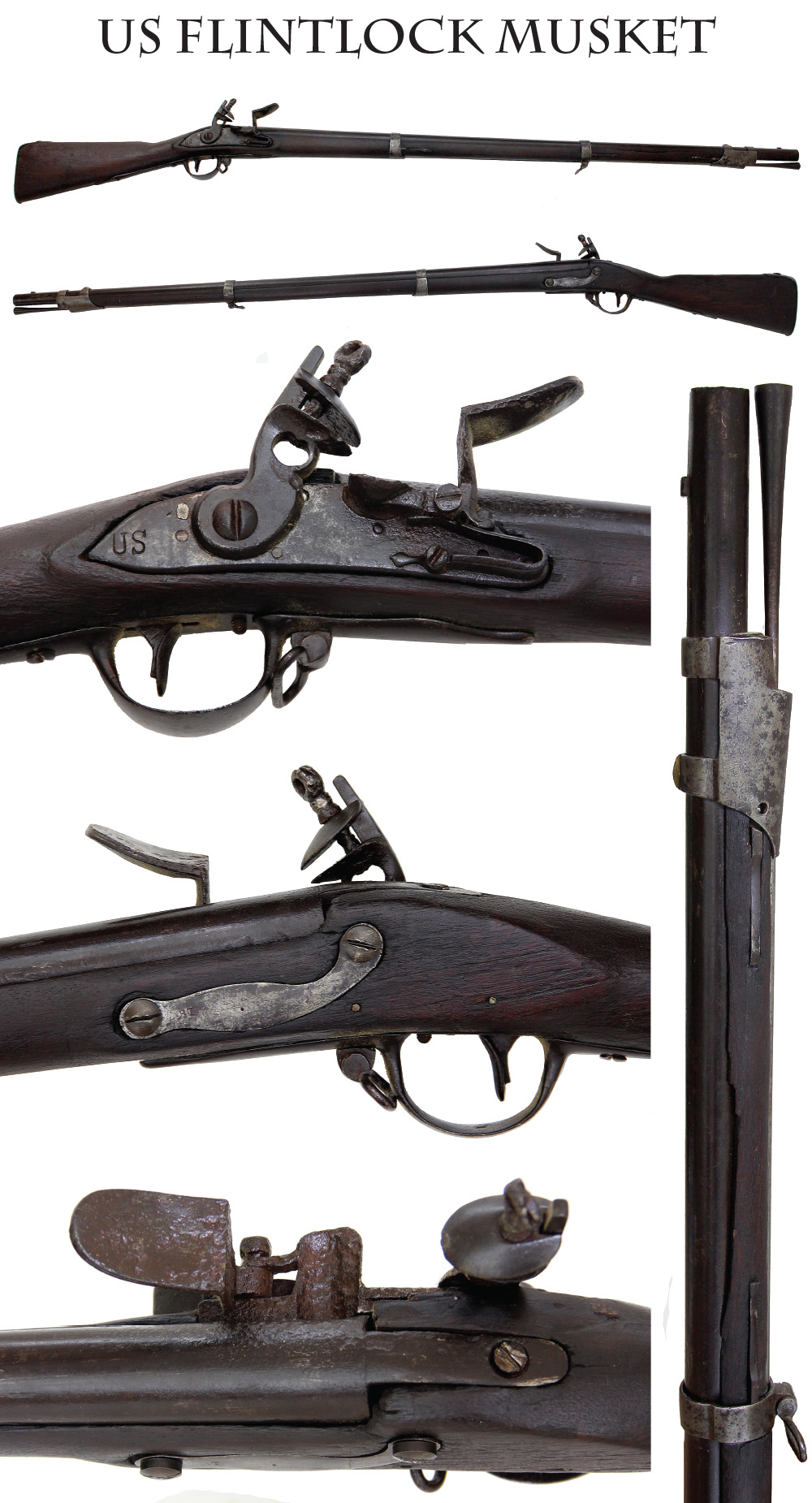
14-09-15 … Early US Flintlock Musket …
The U.S. government gave contracts to a number of gun makers for 7,000 new made muskets on the Charleville pattern between April 1794 and December 1795. The pattern decided upon was the 1766 Charleville with the updates of 1768-71. What little is known about these muskets involves the suppliers from the Philadelphia area, but it is clear the government supplied them with parts for making the guns and the parts were of mixed origin and models, mostly French and in store since the Revolution, along with some others of US make, and some more recent purchases or imports. The muskets produced thus varied, some following the 1766 pattern and others following the later 1773 and 1774 patterns depending upon the parts supplied. In any case, the guns were not marked by the makers and until 1797/98 were not marked for proof or inspection either. Ours is characteristic of this production: it follows the French pattern in general and is completely unmarked with exception of an early Federal period US stamp on the lockplate showing it was accepted into Federal stores. Some roughness and deep corrosion at the breech, flashpan and forward part of the lockplate, but otherwise the metal is good. Barrel a deep brown overall. Bands a tad lighter. Top mounted bayonet lug. Rod old, likely an early replacement. Frizzen screw an old replacement. Some shrinkage gaps at rear of plate. Thick stock typical of the 1774 French patterns. Minor top edge loss to barrel channel of forestock between the bands. Parts for these guns were supplied to the contractors into 1800 and their delivery overlaps with the 1798 contracts. The lack of maker and inspector marks on this one makes it a likely candidate not only for the 1794 contracts, but for one of the early deliveries and typical of the arms used by the army on the early frontier in the 1790s. An interesting early musket from the beginning of our republic, and a good solid example … fej
… $1,295.00 SOLD
Click Here to E-mail Us!
Call us @ 419-842-1863

14-09-16 … 14-08-17 … 1855 Springfield Pistol Carbine:
A solid, representative example of a very scarce gun that is a key piece for a US arms collection. One of only three handguns made at the Springfield Arsenal for the army, the pistol-carbine was meant to fill a dual role for troops fighting on horseback and on foot. A tad over 4,000 were made from 1855 to 1857 before common sense and the Colt revolver replaced it. These are .58 caliber and used the revolutionary Maynard tape priming system, which turned out to have its own problems. Ours is NRA Very Good condition. 100% original, 100% complete, and mechanically perfect. It has a very clear U.S. Springfield marking forward of the hammer, and a visible though rubbed eagle on the primer door. The date at rear of the lock plate is about worn away. The only wart on this is that a previous owner over-stamped the 1855 tang date under the rear sight with a “186”, making it look like 1865. You can clearly see the original “5” under the overstamped “6”. Typical of gun collectors from the 1960s and earlier era who tried to improve markings. Clear VP/eagle proofs at left breech of barrel. Barrel is smooth metal, gray overall. Wood of pistol has been lightly cleaned, but still shows a good cartouche on the left side. A number of dings and dark spots, brass yellowish, but not bright. Mechanism good, rammer assembly, swivel and butt ring in place. Minor firing corrosion near nipple, but nipple is not battered and bolster and screw are good. Bench number 13 on the pistol. Stock shows bench number 5. The original stock is the true rarity on this gun. We find the pistols quite frequently but not the stocks. In fact that stocks command more money as a separate item than the pistols do. I can sell a stock in this condition for the lion’s share of $3000 all by itself. Here is the whole shooting match priced very realistically …
dbej
… $4,750.00 SOLD
Click Here to E-mail Us!
Call us @ 419-842-1863
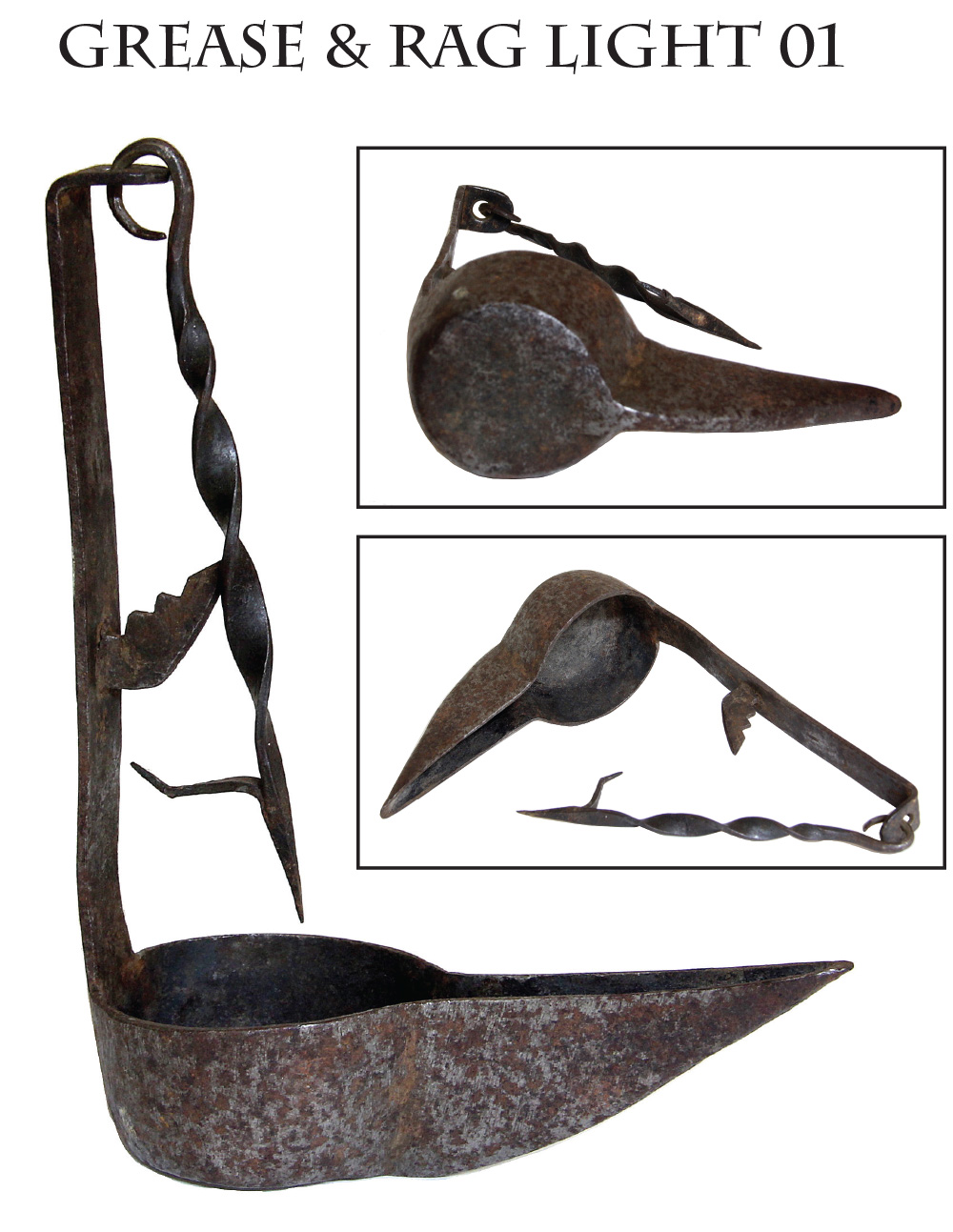
14-09-17 … Grease and Rag Betty Lamp …
The reservoir is 5 inches long. Bottom is 6 inches high. Total height is about 11 inches. The hanger is twisted and has a hook for hanging or a spike for pounding into an appropriate surface. These were filled with animal fat and then had a twisted rag inserted as a wick. Smoky and greasy when used. An honest everyday man’s lamp from the early days, made by hand by a blacksmith, circa early to mid 19th century … ej
… $125.00 SOLD
Click Here to E-mail Us!
Call us @ 419-842-1863

14-09-18 … Grease and Rag “Flashlight” …
This is also an honest everyday man’s lamp from the early days… made by hand by a blacksmith, circa early to mid 19th century. The reservoir is 4 1/2 inches long. Total height is about 4 inches. The top knob is a combination carrying handle and hanging slot. The top disc can be hand held to take with you while moving, or you can utilize the slot in the handle to hang the lamp on a nail in the wall. … ge
… $125.00 SOLD
Click Here to E-mail Us!
Call us @ 419-842-1863
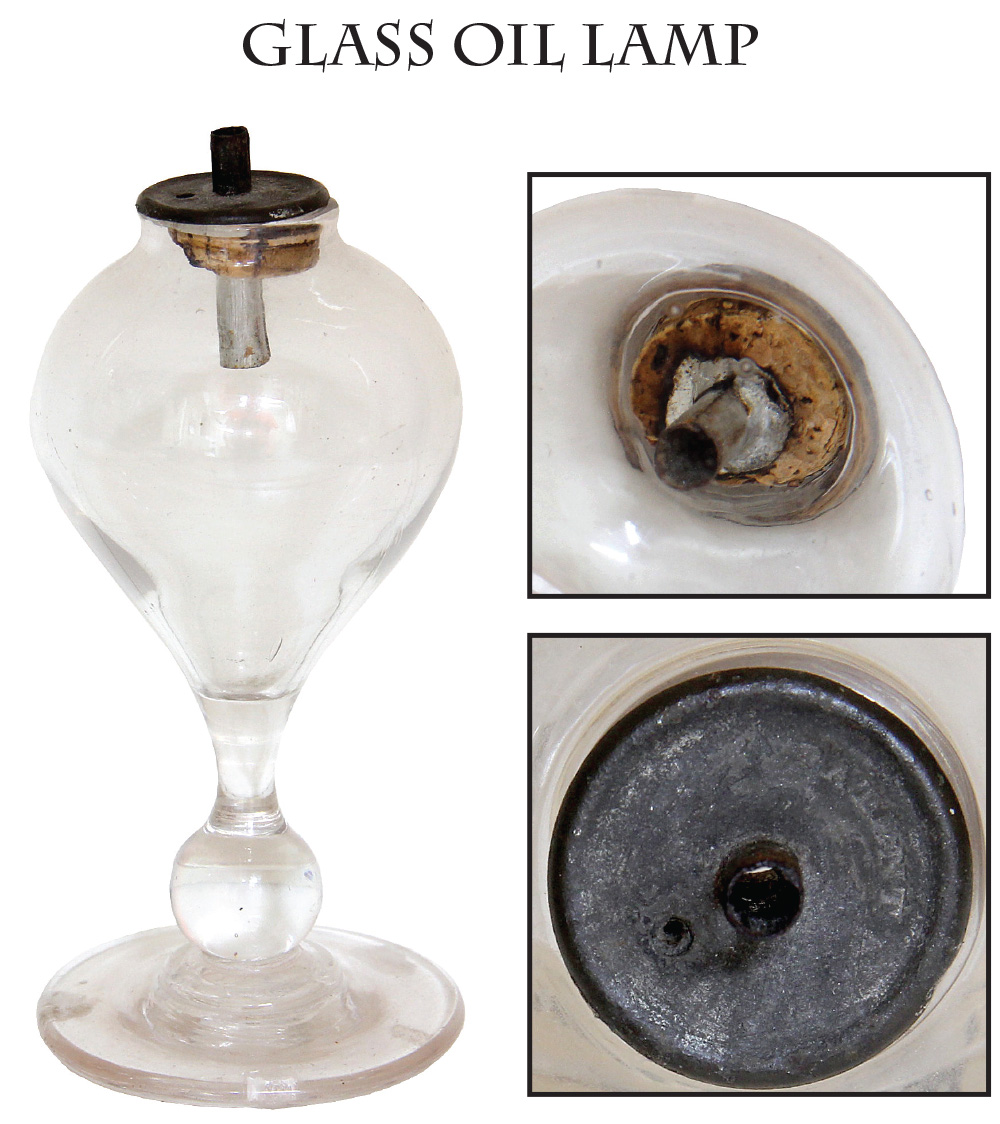
14-09-19 … Glass Oil Lamp …
If not using candles, the average 19th century person used lard, oil or some other rendered fat in a single burner oil lamp such as this. The day went from sun up to sun down whether you were a farmer or a soldier. Here is a very nice basic antique glass oil lamp circa mid 19th century. This glass lamp is in very good, used condition, and is without visible chips or cracks. The glass base is 2 1/2″ in diameter and it stands about 5″ tall. Base of burner bears faint PATENT mark. May have had a globe originally, but may also have been made for use just the way it stands
.
A nice personal item for home use or display with officer’s effects
… $100.00 SOLD
Click Here to E-mail Us!
Call us @ 419-842-1863

14-09-20 …
Mexican War – Civil War Model 1842 Springfield Musket dated 1844:
A very representative example of the large bore .69 caliber Model ’42 and even more desirable with the Mexican War date of 1844. 100% original 100% complete and mechanically perfect. Stock is very nice with worn edges, pretty color, and no damage beyond normal wear. Cartouche marks we see on about 50% of the Model 1842 muskets, and this is one that has it. The steel is a mid-tone gray with some pitting in the tang/hammer area – but still very attractive. All metal stamps are crisp. Lock is dated 1844, Springfield, eagle, etc. … barrel tang date is no longer present. Barrel breech inspector’s marks V.P. over eagle’s head less clear but still visible. These .69 caliber muskets were the last produced in the large .69 caliber size. They were used heavily in the first two years of the Civil War by both Union and Confederate infantry forces, and by the rebs for the remainder of the war as well. Very nice condition and very nicely priced at … zxajjj
… $1,275.00
SOLD
Click Here to E-mail Us!
Call us @ 419-842-1863

14-09-21 … M1849 Austrian Rifle and Bayonet …
This Austrian Rifle M1849 Augustin .71 cal. was manufactured by Ferdinand Fruwirth, Vienna, Austria as a standard model 1849 Austrian rifle. This example has a 33″ barrel. They were rifled with 12-grooves and featured a brass butt plate and trigger guard. AKA: Garibaldi rifle. Both the M1842 and the M1849 rifles utilized socket bayonets having long straight “saber” blades, one included with this rifle today as shown. Adapted to standard percussion in the same manner as the M1842 yager rifles, more than 25,000 were sold to the U.S. War Department in 1862 and 1863. Overall Very Good condition. The gun functions perfectrly and shows expected wear and minor pitting is expected with its age. A solid representative example of a scarce import Civil War rifle complete with saber bayonet. … hjj – veg
… $1,150.00
Click Here to E-mail Us!
Call us @ 419-842-1863
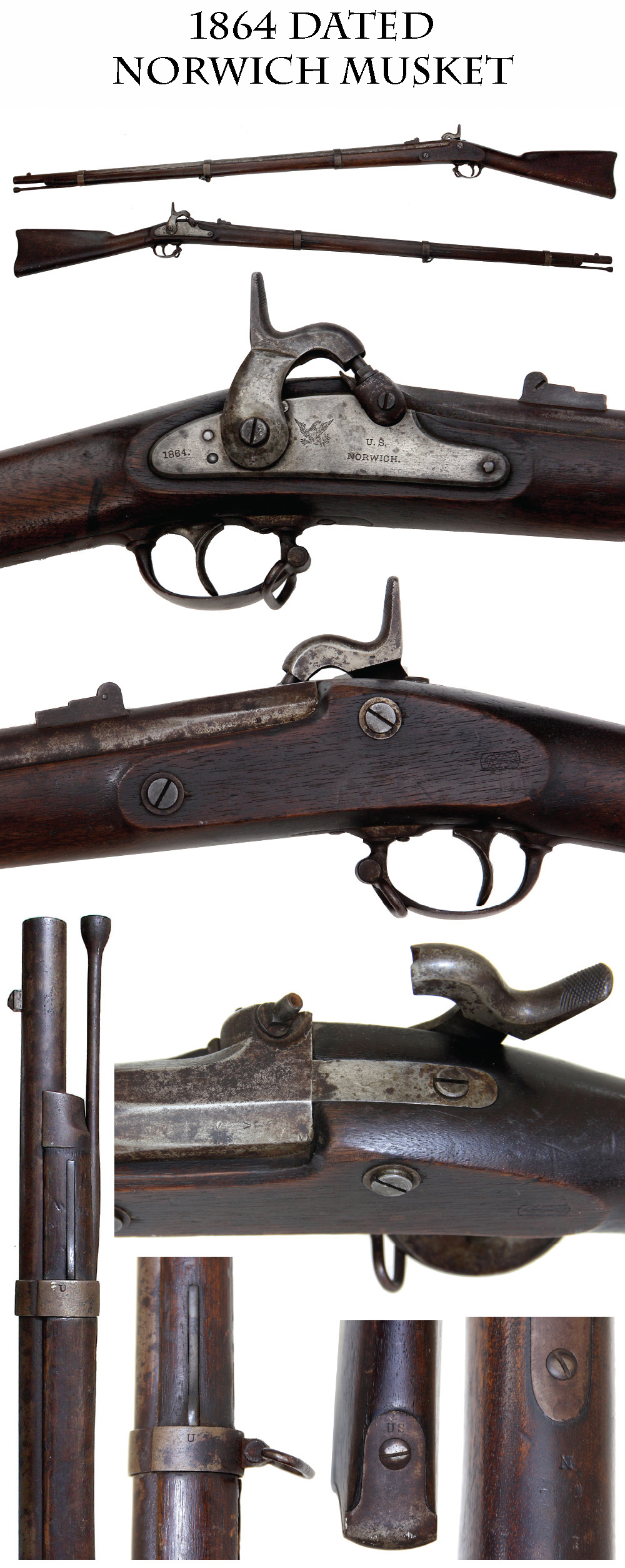
14-09-22 … M1861 Contract Springfield / 1864 Dated Norwich Musket …
The Model 1861 Springfield pattern was the primary rifle musket used by Union forces during the Civil War. Single shot .58 cal. rifled muzzle loader featuring iron buttplate, “C” shaped hammer, bolster with clean out screw and two leaf sight. Three flat barrel bands held in place with springs, sling swivels on middle band and trigger guard, tulip head ramrod with bulged shank and threaded end, iron nose cap and trigger guard are also features of this gun. Springfield Armory supplied gauges and technical data to the various contractors. In order to fill shortages, production was contracted by the fed eral government to a number of private manufacturers, including Norwich. Norwich Arms Co., Norwich, Connecticut This firm produced 25,000 muskets under the contract. Lock is marked “1864.” behind the hammer, with eagle and “U.S. / NORWICH.” in front.. Of the barrel marking “VP” over eagle head and “1864”, only the “VP” is still legible. Butt plate is marked “US” and the three bands each are marked “U”. Very clear inspector’s cartouche in wood on left side opposite the lock. Barrel length 40 inches. Overall VG condition. 100% original, 100% complete, and mechanically perfect. The standard Union infantryman’s shoulder weapon … aazz-port
… $1,450.00
Click Here to E-mail Us!
Call us @ 419-842-1863

14-09-23 … English Flintlock Pistol …
18th century barrel, 18th century brass trigger guard and thimbles, 19th century lock, stock, and side escutcheon. This is an example of Ketland utilizing very early parts when building a gun in the early-mid 19th century. A flower head adorns the lock plate in front and behind the hammer, with another on the hammer. Marked inside the lock is “W. Ketland & Co.” (you must remove the lock to see it.) The barrel is circa 1750 with intricate engravings and cartouches. A neat early gun with much character and very affordable. Super … tejjy
… $695.00 SOLD
Click Here to E-mail Us!
Call us @ 419-842-1863

14-09-24 … ID’d 22nd NY Cavalry Sharps carbine, framed poster, Belt / Buckle / Cap Box and Reunion Ribbons …
Sold by the family to a Dayton, Ohio gun store this year, this set is fresh to the Civil War market.
George Keyes (or Keys) was 19 years old when he enlisted at Lyons, NY, in the 22nd NY Cavalry on 1/5/64. The unit was also known as the Rochester Cavalry, and recruited in the Rochester area starting in the Fall of 1863 and mustering into service from December through February. Keyes mustered into Co. H as a private on 2/2/64. They served with the 9th Corps until April, 1864, when they joined the Army of the Potomac. In the Fall of 1864 they joined the Army of the Shenandoah, and in early 1865 the Cavalry Division Army of West Virginia, losing 3 officers and 20 enlisted men killed or mortally wounded, but seeing action in a large number of skirmishes and engagements. CWData lists 37 occasions where the suffered casualties, including men lost at prisoner to the enemy, including one soldier listed as being taken prisoner in June, 1865! Keyes mustered out 8/1/65 at Winchester, Va.
The saber belt is a typical mid to later war pattern buff belt with rivets in addition to stitching and an eagle plate with a one-piece wreath. The belt lacks the saber slings, but is otherwise in good solid shape, though a bit dirty, with hasp, D-rings and square ring in place. It even has the original cap box still in place, showing some wear and finish loss from flexing. The belt was stored in a small cardboard box labeled in the top and sides in pencil: “Grandfather Keyes Army Belt 1861 for George Quinn.” The 1861 date is a typical mistake for a soldier’s relative to make, taking the beginning date of the war for their relative’s service. The “Soldier’s Memorial” is a good example of one of these wartime multicolor rosters soldiers would subscribe for in camp. George Keyes appears in the right hand column, sixth man down, spelled as “Keys.” A list of the regiment’s engagements is printed at the bottom in three columns and extends to their service at Knoxville in November, 1863. James G. Van Marter is listed as Captain, and since he was dismissed in July, 1864, the memorial must have been put together between those two dates. The frame is likely the original one first used to hang it up at home. The GAR items include the bottom to a typical GAR membership medal, a RARE GAR post quartermaster sergeant’s metal pin with a tattered flag ribbon and a separate celluloid disk showing soldiers at a campfire attached to a ribbon fragment, and lastly a tattered post ribbon from Benedict Post 429 in Pleasantville, Pa. The centerpiece is Keyes’s New Model 1863 Sharps Carbine with his initials carved on the left side below the buttplate tang, along with a small bullseye design on the other side. The gun has a lot of oxidised blue that has turned to a pleasing purplish plum brown. The case hardening on the receiver is a more mottled silver and gray on the left, but showing some of the typical cloudy faded case behind the hammer. Generally a tight wood to metal fit. Very clear Sharps patent information on the receiver and lockplate, legible manufacturing and model information on the barrel just a little rough, good Lawrence patent sight marking. Forestock shows a narrow crack from receiver to screw but is solid. Serial number C,15652 shows a late 1864 production carbine. Mechanically fine. A nice war veteran cared for by the family and treasured as a memento of service. A wonderful REAL cavalry grouping fresh from the family. This stuff just does not come up very often in the 21st century. A great hunk of history. Extra shipping due to the frame … zbhjj
… $3,650.00 SOLD
Click Here to E-mail Us!
Call us @ 419-842-1863

14-09-25 … Boot Pistol …
Mid-19th Century single barrel percussion boot pistol. “Flower” type cartouche on each side, center-action hammer and cannon style barrel. Likely Belgian made. This gun functions properly, is 10″ in overall length … looks to me like one of the brass trigger guard screws has been replaced, but still a neat piece at a friendly price … abez
… $195.00 SOLD
Click Here to E-mail Us!
Call us @ 419-842-1863

14-09-26 … 6th Indiana Cavalry Identified Burnside Carbine Service in Tennessee and Kentucky. sn 30088
Burnsides were widely used and show up in a number of variations. The common feature of the patent is a breechblock that pivoted down at the rear and up at the front for insertion of a tapered brass cartridge that had a small hole in the base for ignition by percussion cap. This carbine has the key feature identifying it as the so-called Fifth Model, introduced in 1863: The guide screw on the right side of the frame to make the operation of the breech block smoother, but it also shows some earlier characteristics: The barrel stamp reading “Cast Steel 1862” (the last digit a little light) and the marking at the top of the frame reading: “Burnside’s Patent / March 25th, 1856.” The carbine shows a number of assembly and sub-inspector’s markings and two very obvious cartouches on the wrist aft of the sling bar. Matching serial number 30088 on both the block and receiver. This serial number shows up in Springfield arsenal research services as being issued to Co. “E” 6th Indiana Cavalry. Here is a short history of the regiment ….. This regiment the 71st of the line, was organized as infantry, mustered in Aug. 18, 1862, and sent immediately to Kentucky to assist in repelling Kirby Smith’s invasion. It was engaged in the battle of Richmond, where it lost 215 in killed and wounded and 347 prisoners, Lieut.-Col. Topping and Maj. Conkling being among the killed, and only 225 escaped capture. The captured were paroled, returned to Terre Haute, and were exchanged late in the fall. It returned to the field on Dec. 27, when 400 of the regiment were sent to Muldraugh’s Hill to guard trestle work and the following day they were surrounded by 4,000 of Morgan’s cavalry and captured. The regiment returned to Indianapolis where it remained until Aug. 26, 1863. It was changed into a cavalry organization, Feb. 23, 1863, and two additional companies were organized and added during the year. It was engaged in the siege of Knoxville; in the operations against Longstreet on the Holston and Clinch Rivers, losing heavily, in killed and wounded; was ordered to Mt. Sterling, Ky., in the spring of 1864, to be remounted; and was stationed at Nicholasville, Ky., until April, when it moved to join Sherman’s army at Dalton. It arrived there May 11, was assigned to the 2nd cavalry brigade Army of the Ohio, and participated in the battles of Resaca, Cassvilie, Kennesaw Mountain, and other engagements of the movement upon Atlanta. It aided in the capture of Allatoona Pass and was the first to raise a flag upon Lost Mountain. It took part in Stoneman’s raid to Macon, GA, losing 166 in killed, wounded and captured, and returned to Nashville on Aug. 28, where it was remounted and sent in pursuit of Wheeler’s cavalry. It took part in repelling Forrest’s invasion of Middle Tennessee being engaged with his forces at Pulaski, and pursuing him to Waterloo, Ala. On Nov. 1 it moved to Dalton, GA, and on the 26th returned to Nashville. The regiment was engaged in the battle of Nashville and joined in the pursuit of Hood after the battle. It remained at Nashville until Apr. 1865, when it moved to Pulaski with the 2nd brigade, 6th division, cavalry corps, Military Division of the Mississippi. The original members of the regiment to the number of 425 were mustered out at Pulaski, Tenn., June 17, 1865, and the recruits whose terms did not expire before Oct. 1, were consolidated with the recruits of the 5th cavalry, the new organization being designated as the 6th Ind. cavalry. It remained in Middle Tennessee until Sept. 15, 1865, when it was mustered out at Murfreesboro. The original strength of the regiment was 1,200; gain by recruits, 548; total, 1,748. Loss by death, 260; desertion, 105; unaccounted for, 72. As for the gun’s condition … Very Good … the wood is very good overall with a tight fit with the metal. The metal is a uniform bright mixed with scattered gray spots… nice look. Triggerguard and hammer are the same color, with some faint hints of case color on the block assembly when loaded. Sights, swivel, band all in place. An interesting carbine with history
… $1,850.00
SOLD
Click Here to E-mail Us!
Call us @ 419-842-1863
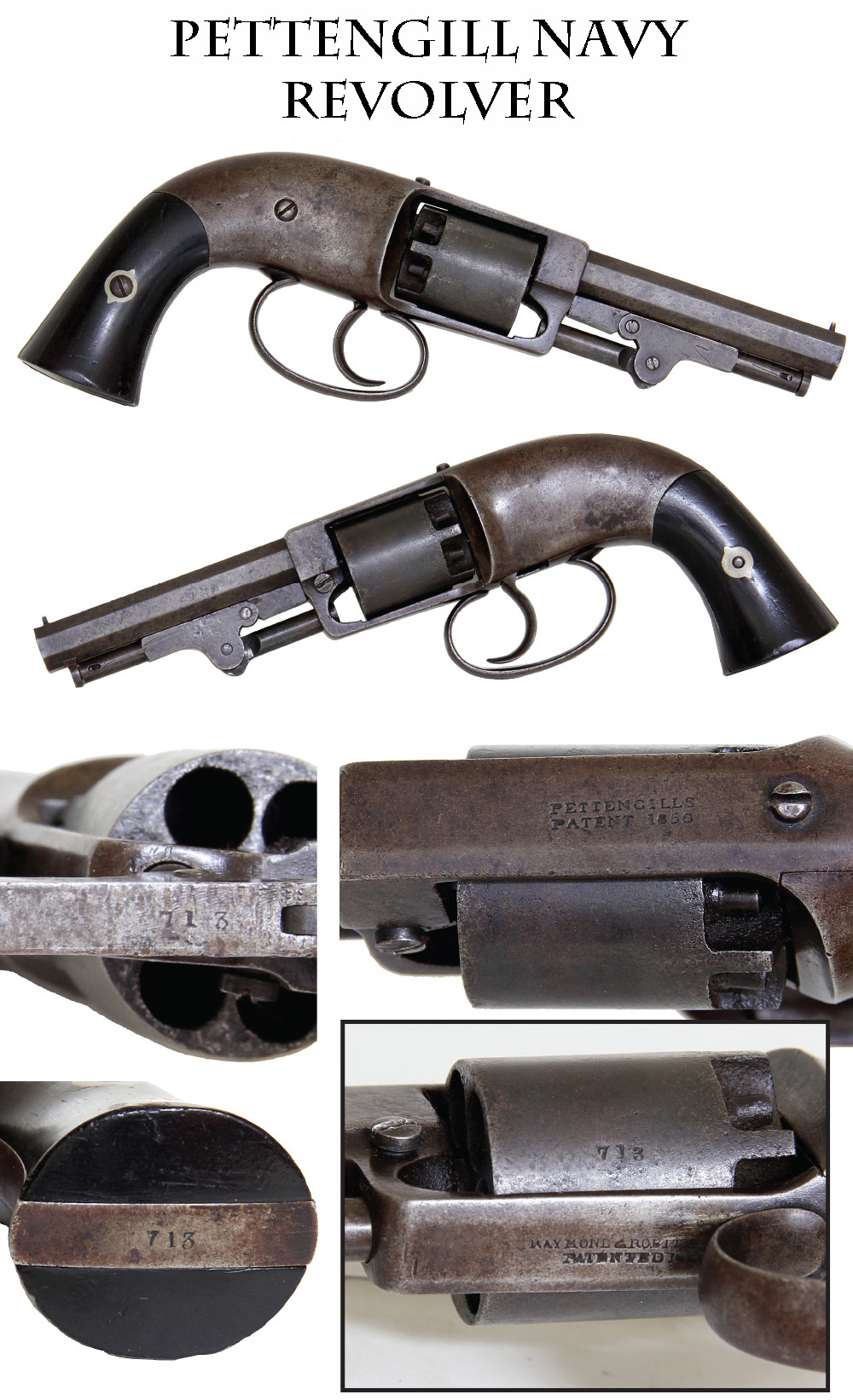
14-09-27 … Pettengill Navy Double-Action Revolver …
The double-action Pettengill was the only martial revolver to use an internal hammer. This Navy, or Belt Model, was an improved version of the earlier Pocket Model Revolver and featured a greater overall size and larger caliber than its predecessor. Barrel is 4.5 inches long. Overall size about the same as a Manhattan Navy revolver. Pettingill revolvers were manufactured by Rogers & Spencer of Willowvale, New York c. late 1850s. It is self-cocking only. The L-shaped hammer is concealed within its frame. Pulling the trigger revolves the cylinder, fires, and cocks the hammer for the next shot. Its pepperbox-like mechanism was patented by C. S. Pettengill of New Haven, Connecticut, U. S. Patent 15,388, July 22, 1856, improved by Edward A. Raymond and Charles Robotaille of Brooklyn, New York, U. S. Patent 21,054, July27, 1858, and Henry S. Rogers of Willow Vale, New York, U. S. Patent 36,861, November 4, 1862. It is 36 cal. and is very good to fine condition with traces of original blue. Clearly marked “PETTENGILL’S / PATENT 1856” on top of the frame and “RAYMOND & ROBITALLE/ PATENTED 1858” on bottom. The frame, trigger guard, barrel, cylinder and loading lever are numbered “713”. Smooth 2-piece walnut grips. A very scarce Civil War revolver. Only 900 were manufactured and those were in 1862 or earlier… Very few survive in this condition. … xxafej
… $2,150.00 SOLD
Click Here to E-mail Us!
Call us @ 419-842-1863

14-09-28 … Cut down import Musket turned into a musketoon …
This old war horse Started life as a French pattern 1822 musket. At some point in its history it was shortened to carbine length. From a romantic standpoint we could hope this was done by the Confederacy. But objectively we have no way of knowing for sure. Still, it is perfect for a Confederate cavalry display at a very affordable price. Overall good working condition. The original ramrod is still present . A “Crown over AF” mark is still legible on the lockplate as well as “Crown over G” proof marks on the left side and underside brass of the gun. … k-wag
… $365.00 SOLD
Click Here to E-mail Us!
Call us @ 419-842-1863
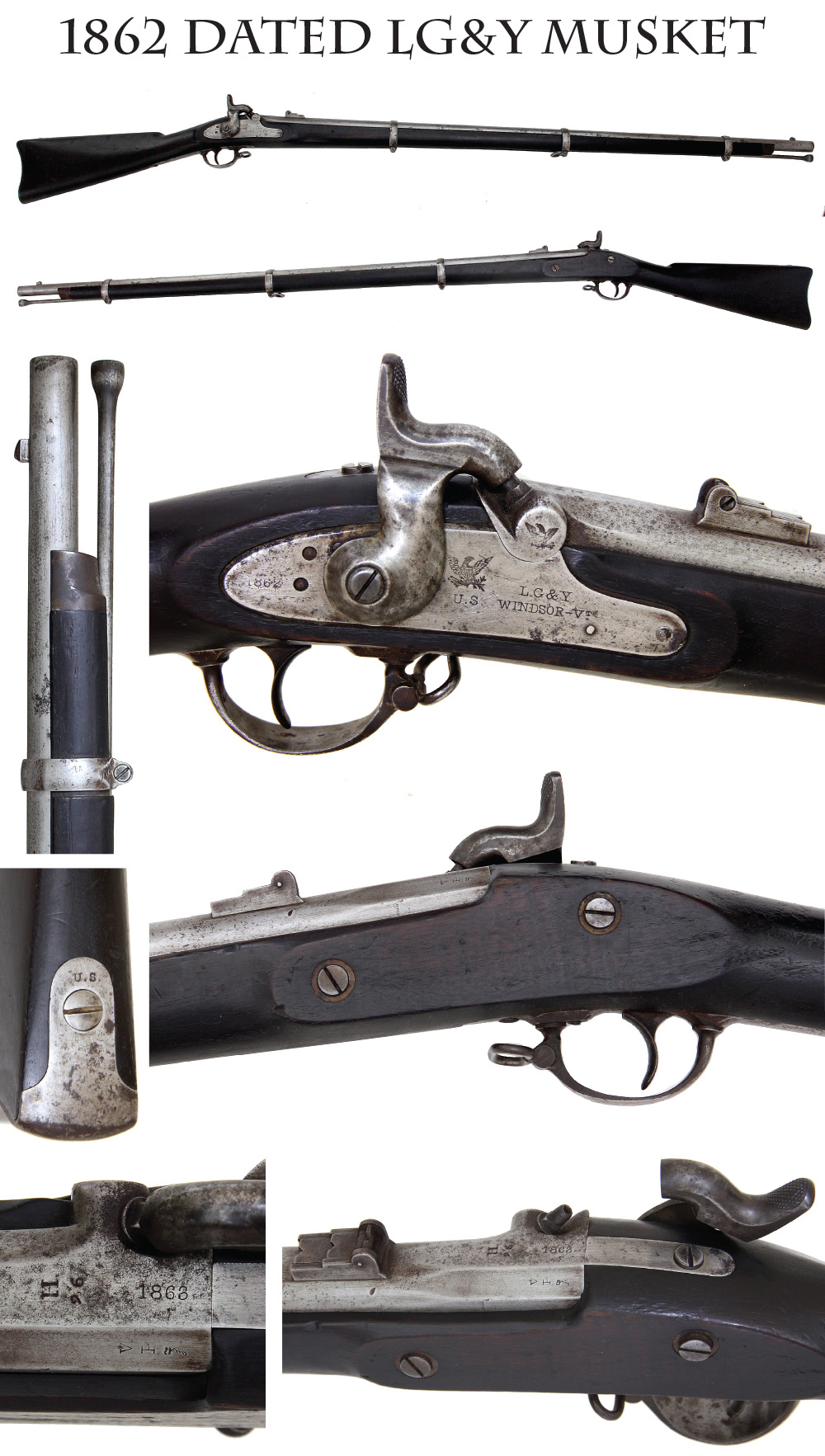
14-09-29 … Special Model 1861 Musket …
The “Special” Model 1861 contract did not conform To the US pattern 1861 Musket. It was based upon the English Enfield pattern, having friction screw tightened barrel bands and a straight ramrod. In 1863 Springfield essentially copied this model. Lamson Goodnow & Yale Co., Windsor, Vermont produced approximately 50,000 muskets under this contract. Overall very good condition. 100% original 100% complete and mechanically perfect. Lock is marked “1862” behind the hammer, with eagle over “US”, and “L G – & Y / WINDSOR – VT – The barrel is dated 1863 showing this gun was likely made early in 1863 utilizing the lock made in December 1862. ” Also present on the barrel is a regimental rack marking of “H 96” indicating it was issued to soldier #96 in Company H of the regiment. A good solid example of an early war rifle musket
… $1,350.00 SOLD
Click Here to E-mail Us!
Call us @ 419-842-1863
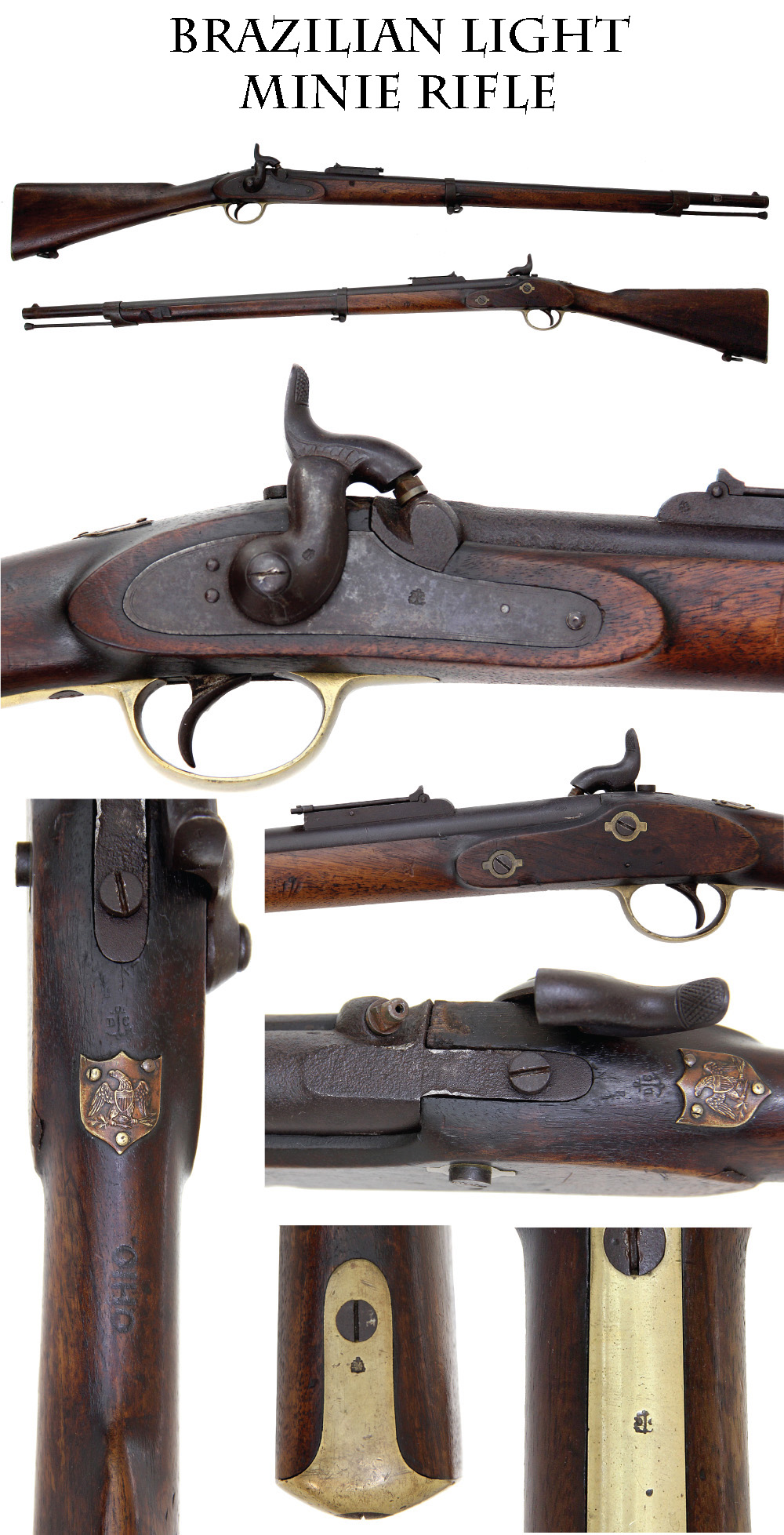
14-09-30 … Ohio Marked Brazilian Light Minie Rifle …
This is one of the most attractive of the percussion rifles used during the American Civil War. The
Brazilian
Light Minié Rifle
, manufactured by the
O.P. Drissen
company of Liège, was a unique combination of the features found on the British Pattern
1856/58/60
series of Enfield short rifles and the French Light Minié rifle. This .577 caliber rifle was designed to accept a straight bladed saber bayonet, and the guns imported by US purchasing agents are readily identifiable by the classic brass shield with an eagle on the wrist of the stock. The guns have the OP Drissen maker mark of a
D –Anchor – C
on the lock and most of the metal parts. The
D – (ANCHOR) – C
makers mark typically appears on the breech, lock, butt plate, barrel bands and trigger guard of the guns. This same mark also appears on the obverse ricasso of the saber bayonets that were manufactured by
S&K
(SCHNITZLER & KIRSCHBAUM of Solingen) for use with the rifles. The US Government purchased around 6,000 of these rifles and if my memory serves me, the brass eagles were added in Cincinnati, Ohio. The story goes that these Belgian made guns were part of a contract destined for the Brazilian military, but ended up being sold to US buyers instead. From time to time, these guns also show up with state of Ohio ownership marks, and this happens to be one of those scarce examples! The gun shows the honest age one would expect from a 150-year-old military rifle that saw service – but one that was well maintained and in Very Good condition. This is a fine piece in top notch condition and much eye appeal. Completely original and genuine in all respects … hx-fjol
… $1,495.00 SOLD
Click Here to E-mail Us!
Call us @ 419-842-1863
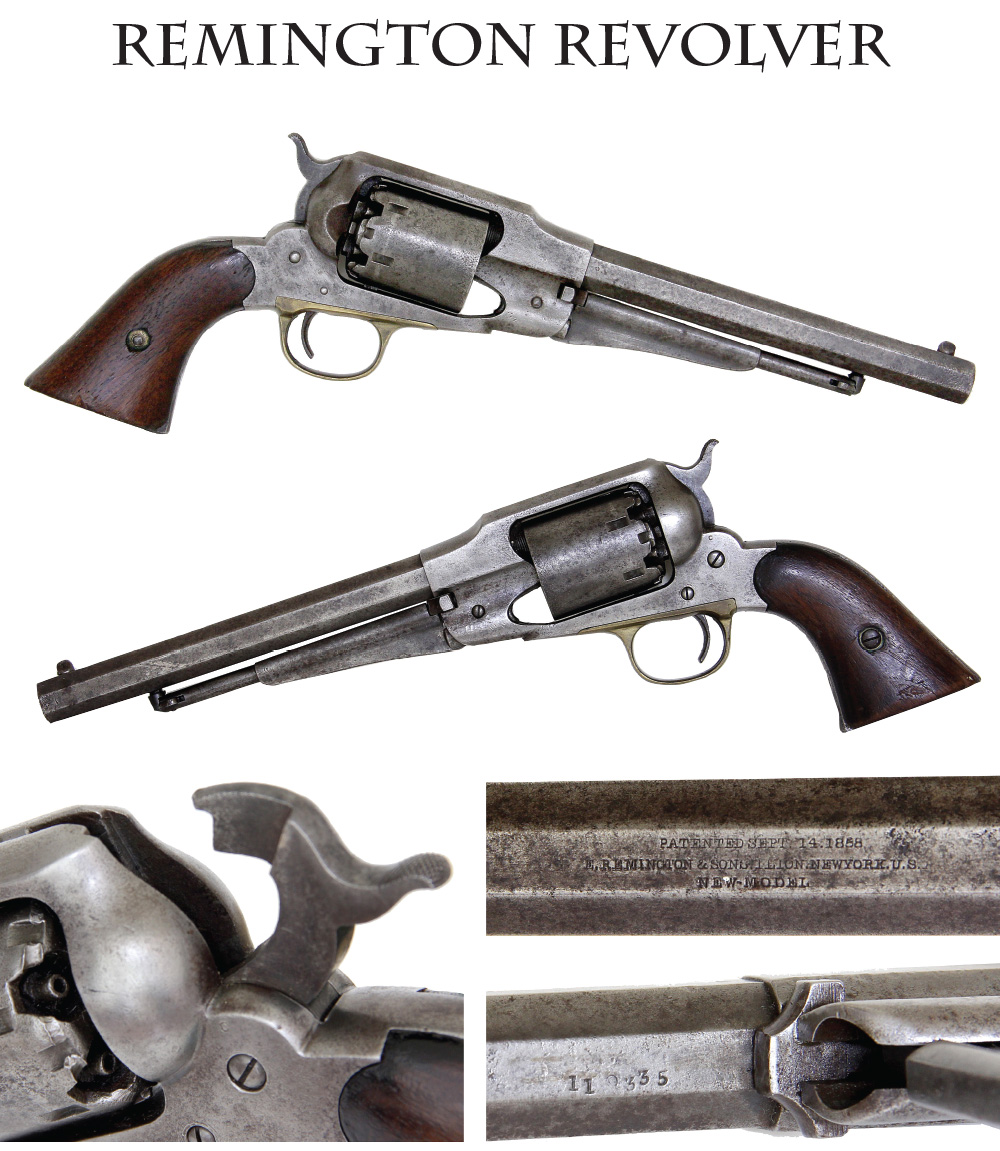
14-09-31 … Remington Revolver …
A very solid example of the standard Remington New Model Army revolver and this one with a serial number of 110335 or 119335… can’t see the third digit clearly. It was used – and well maintained. This great old gun is 100% original, 100% complete, and mechanically perfect. The metal is an honest gun metal grey color showing just normal handling and no rust and only hints of pitting. The grips are likewise nice – again showing use but not abuse. The two line barrel legend and firm marking is totally legible. When issued, these Remingtons were in about the same quantities as the Colts and were actually a stronger and more advanced design than the Colts with the Remingtons having solid frames with top straps just like present day modern revolvers. Also, the Remingtons could be easily reloaded with a fresh full cylinder without the need of tools, whereas the Colt could not. This is a good solid revolver that you will be well pleased with. .. zzh
… $1,150.00
SOLD
Click Here to E-mail Us!
Call us @ 419-842-1863
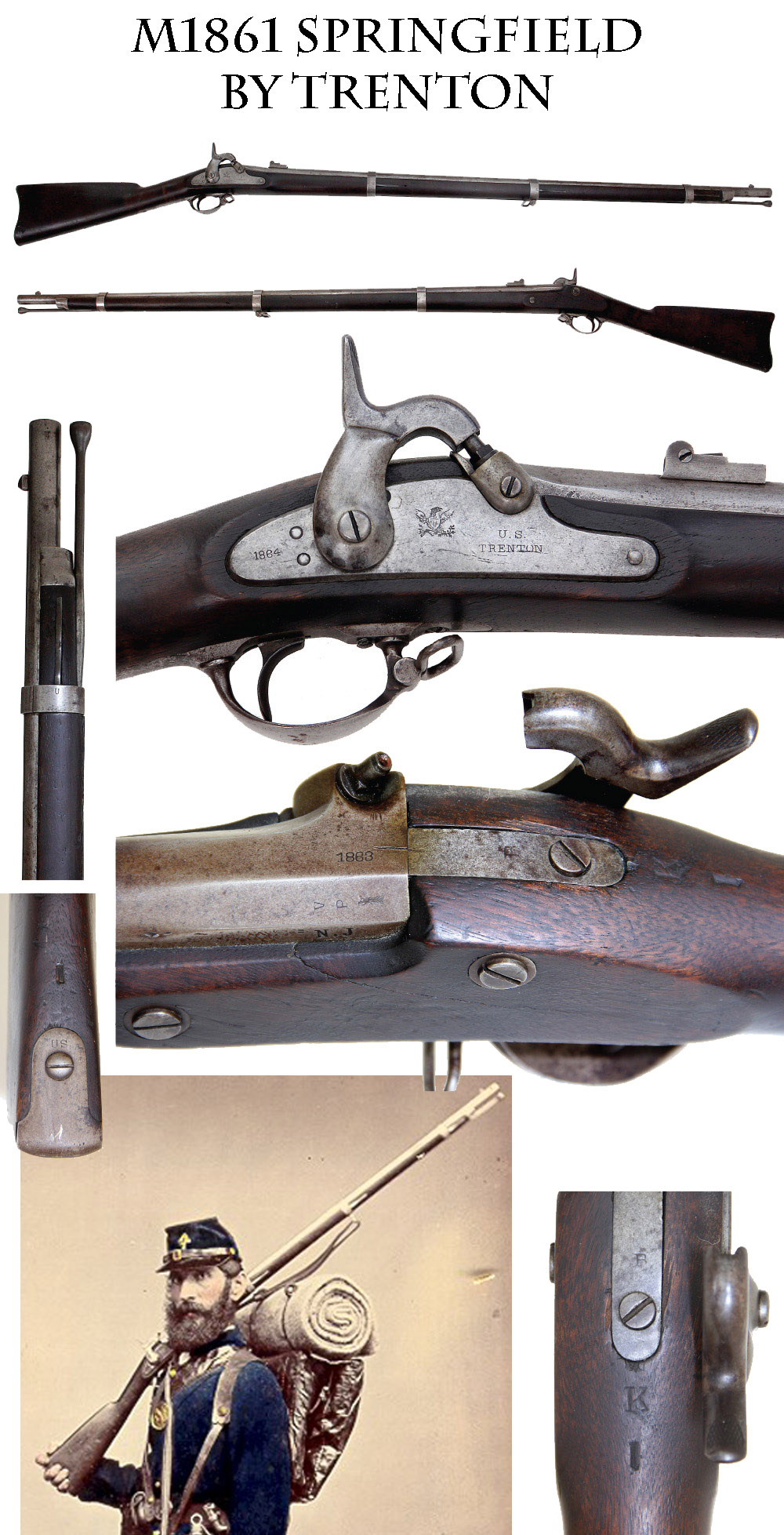
14-09-32 …
New Jersey Marked Model 1861 Springfield Contract Musket / TRENTON.
A Very Good example of the standard Union Army infantry weapon, p
roduced by Burt and Hodge at the Trenton Locomotive and Machine Company.
A.M. Burt and J.T. Hodge were partners in leasing the Trenton New Jersey facility to produce Springfield Model 1861 rifle muskets for the US government and the state of New Jersey, on contracts taken in each of their names. This is one of the NJ guns. Crisp 1864 date rear of lock, eagle and U.S. / Trenton forward. 1863 barrel date, (likely assembled January 1864), crisp V/P/eagle proofs left barrel flat. Metal is smooth grey steel overall with sharp markings. Area around bolster is excellent, screw slots fine, Wood edges are sharp and show only mild handling wear. Super wood-to-metal fit. Bands, springs, rod, swivels, etc., all correct and in place. Barrel stamped NJ and stock cartouched NJ still lightly visible shows purchase by the state of New Jersey for her troops. Very strong condition overall with the only blemish of significance being a stress crack in the wood on the back side opposite the lock. Rack or company letters stamped into wood and barrel tang. It is a solid example of a midwar contract rifle-musket that soldiers were glad to get to replace the early war European “fence rails” they had had been using to kill each other with earlier in the war. It will display like gangbusters with a good belt set and cartridge box rig. A very fair price for a gun of this quality … qab
… $1,450.00 SOLD
Click Here to E-mail Us!
Call us @ 419-842-1863
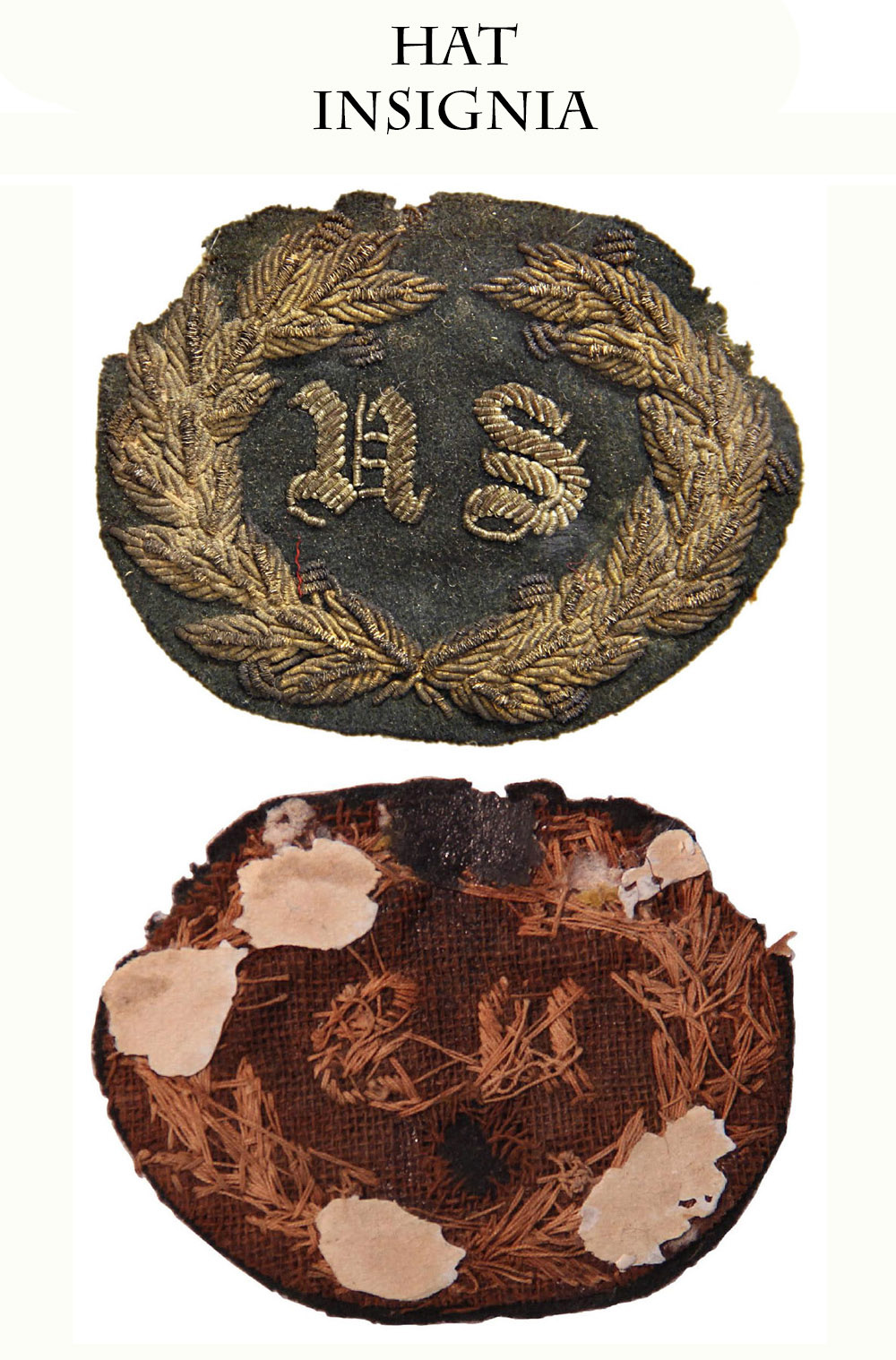
14-09-34 … 14-02-71 … Regulation Union Army Staff Officer’s Hat Wreath:
One of the scarcer pieces of bullion embroidered insignia from the Civil War is this US Staff wreath. This one is medium large size, just under three inches across. Front has standard wreath with Olde English “US” inside the wreath. Back is a “raw back” with exposed threads. Back also shows where it was glued to a display board at one time. Darn rare piece of insignia
… $350.00 SOLD
Click Here to E-mail Us!
Call us @ 419-842-1863
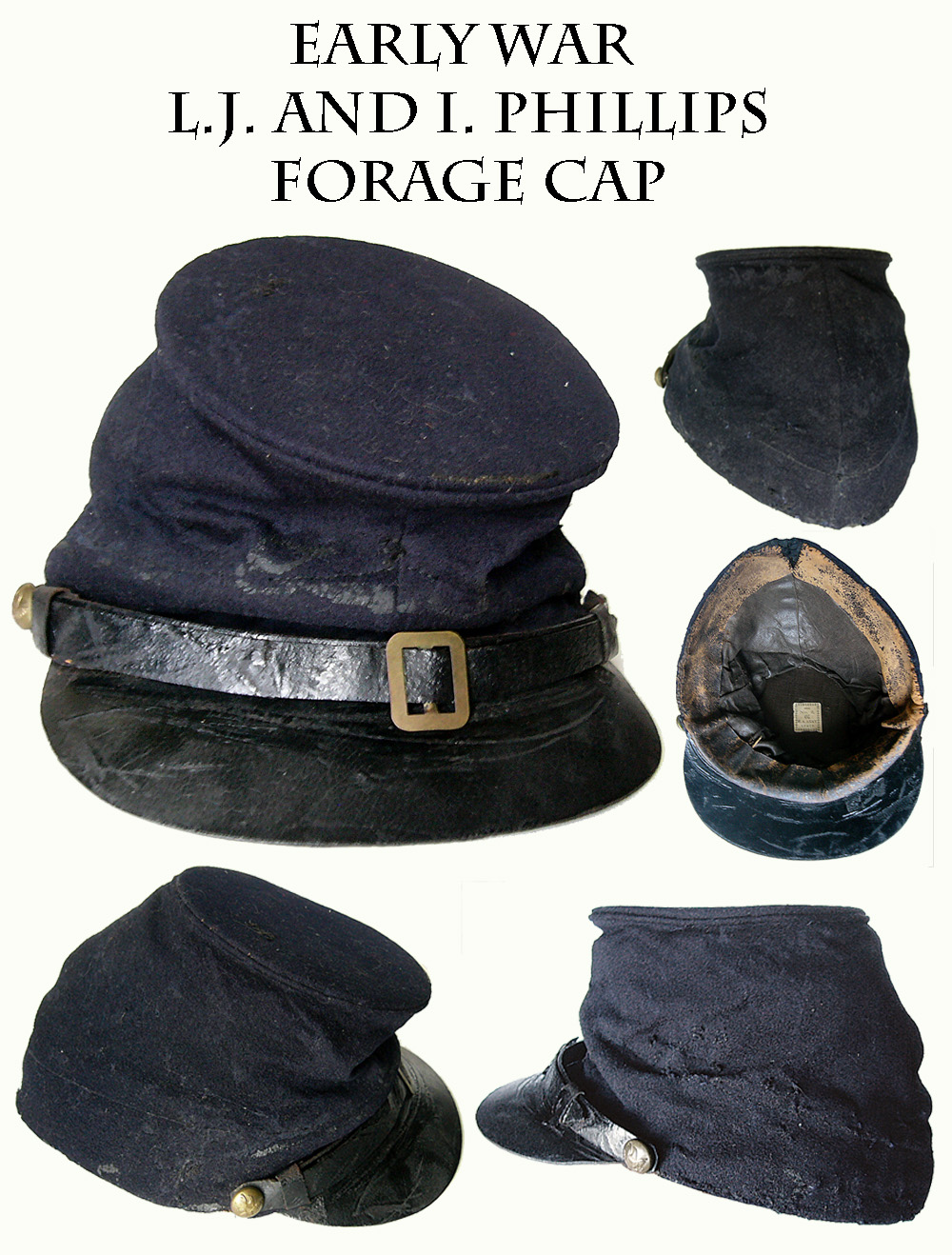
14-09-35 … Early War L.J. and I. Phillips Forage Cap
… Lewis J. and Isaac Phillips of New York City had contracts with the government for well over half a million forage caps from 1861 through 1865. Most of their existing caps are from their later contracts and are the so-called “Type-II” pattern with a blockier body, wider crown, and flat visor. This cap represents the “Type-I” style with smaller crown, more tapered body, and crescent-shaped down-turned visor. This was the most common style of cap in the first three years of the war. In the old Smithsonian publication on army headgear Edgar Howell figured they outnumbered the Type-II versions two to one. This one is complete with chinstrap and sliding buckle, side buttons, sweatband and full lining with the original Phillips label inside the crown reading: “SIZE / No. 2, / 6 7/8 / U.S. Army / L J & I P”
Brown polished cotton side and crown linings in place and excellent. Sweatband in place, but restitched on bottom left (wearer’s left) from side button to center rear, where the ends meet. (This was done using the original holes and is not very noticeable.) There is some roughness to the lower left side of the exterior from some moth nips that have been closed up and some moth tracking that removed the nap in a couple of fingernail size areas. This probably explains why the sweatband must have come loose and was restitched. A small piece of black fabric was also sewn in between the fabric of the camp and the sweatband at the very back to anchor the two ends. There is also one small tear or nip that was closed up at the top left of the crown and another at the bottom right just above the chinstrap, about half way between the center line and side button.
This is not a mint surplus example but certainly rates good to very good and is a scarce early war example of the quintessential piece of Civil War headgear by a well known maker
… $2,695.00 SOLD
Click Here to E-mail Us!
Call us @ 419-842-1863
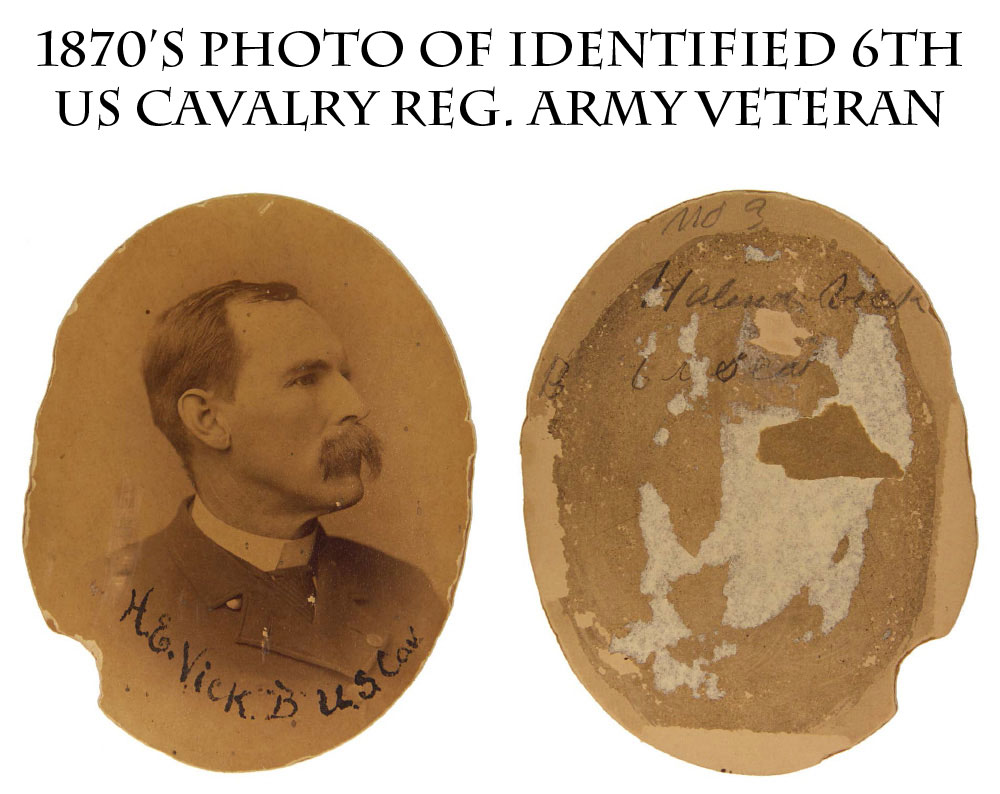
14-09-36 …
14-02-82 … GAR Photo Identified 6th US Cavalry Trooper:
The Sixth US Cavalry was an interesting unit and there is a regimental history just recently released. Recruited in May, 1861, in Pennsylvania and Ohio, the regiment was a new addition to the US army and was originally designated the Third US Cavalry. When all mounted units were redesignated “cavalry” in August the Third changed its numerical designation to the “Sixth.” It was mounted and equipped in Maryland in September, though only two companies were issued carbines until early 1862, the regiment being considered “light cavalry” until then, most companies armed only with pistols and sabers. It then took the field and saw its first fighting with McClellan during the Peninsular Campaign that Spring.
Here is a photo of one of their veterans, wearing a GAR coat by the look of it, with a GAR lapel stud as well, taken about 1890. Obviously removed from a frame at some point. Irregularly trimmed along edge and some edge chipping, glue spots on reverse, but not affecting image itself and would look great matted again. Identified along lower edge in period ink: “H.E. Vick ‘B’ U.S. Cav.” and on reverse “No. 3 / Holend Vick/ B 6 US Cav.” in ink and pencil. Holland E. Vick enlisted as a private in Co. B of the 6th US Cavalry on August 5, 1861. He was discharged for disability Oct. 18, 1862, at Fortress Monroe, but this would have given him service during the Peninsular Campaign and through Antietam. A cursory online search shows a Holland Vick born in Ohio in 1834, and this may be our man, though the regiment also supposedly had a large number of recent Irish immigrants in it. It had a good wartime record though, and many of its officers were transfers from other regular army units when it was first organized
… $30.00
Click Here to E-mail Us!
Call us @ 419-842-1863

14-09-37 … 14-02-94 … 18th Century Ivory-gripped, Silver Inlaid, Iron Mounted Officer’s Short Saber,
Cutlass or Couteau with Clipped Point Blade Profusely Decorated with Panoplies of Arms and Cabalistic Signs. I generally don’t buy early European weapons, but this one really grabbed me. I felt it could have been carried in any number of historical battles. It is a French made sword intended to evoke images of the early exotic ages with talisman marks and some mystical signs associated with the Kabbalah.
Ivory hilt with incised lines running along the edge on both sides of the rectangular-cross sectioned grips. High capstan rivet pommel with slight pistol-grip-flare. Outboard side of the grip has an inset oval silver plaque engraved with a “very French” trophy of arms consisting of a drum, flags, bow and spears. Single knucklebow guard with central eight-pointed star and rays motif on either side with an engraved toothed line on either edge with punch-decorated dots. Slightly downturned flat round quillon that continues the motif into a spiral. Recurved langets with mixed floral and geometric motifs and the same punch decorated jagged border. Small hole at top of knucklebow for a sword knot. Overall length is 33.75 inches. The 28.5 inch blade is single edged with a wide ricasso, single broad fuller and clip point with false edge. Both sides of the blade show an etched or engraved sword-wielding arm appearing out of a cloud at the ricasso. This motif is found on many early swords, 18th century and prior, and represents “The Sword of God”. It can be found on weapons from Europe to the Middle East. A precursor to Germany’s “Gott Mitt Uns”, and every nation’s belief that God is on their side, especially during battle. On the inboard side above this is a trophy of arms, some mystical numbers and letters, a sun with a face and pointed rays, followed by two more rows of mystical signs and lastly a man-in-the-moon looking down on a star. Similar motifs are found on Revolutionary War blades. On the outboard side, a somewhat floral star sits under more mystical symbols. Above that a long oval panel with the face of the sun at top has the bases and tops of pole arms peaking up behind it, while on it is another trophy of arms showing an arrow, quiver, flag and clip-pointed sword like this one. Above that is another set of mystical signs topped by a star. The blade is very clean, just some minor gray and dark spots here and there, slightly more near the tip, but very, very legible from across the room. The grip is extra fine and solid … ivory and silver. Extremely minor chipping at the base near the guard, a couple of dark lines showing from deep inside. The story of the old-testament rooted mysticism of the Cabala or Kabbalah, its roots and many off-shoots in Judaism, Christianity, mysticism, freemasonry, etc., is too vast to deal with here. There were a number of upsurges in interest in its mysticism in Europe starting in the Renaissance. My feeling is that the sword dates about 1750-70 and the owner was either truly interested in the mysticism of the symbols used on the blade or he wanted a blade that evoked the mysterious east: This is very pretty and exotic sword, and one meant for business. Eye catching, fearful, handsome, this one stands out in an edged weapons collection
… $2,500.00
Click Here to E-mail Us!
Call us @ 419-842-1863
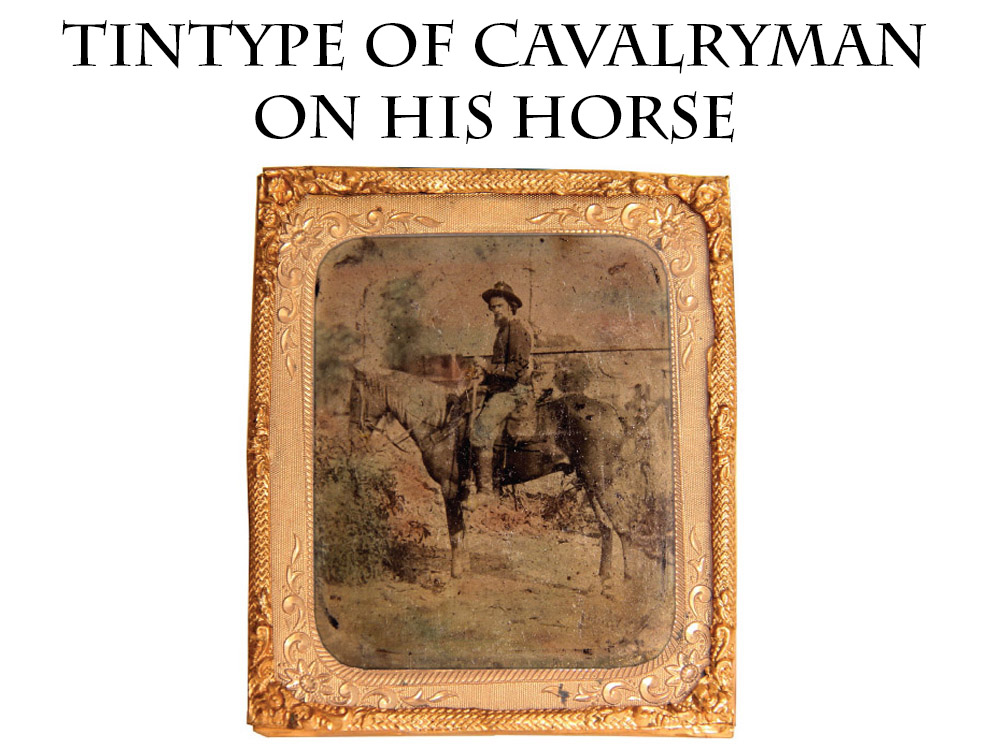
14-09-38 … 14-05-17 … Sixth Plate Tintype of Cavalryman on horseback / Likely Michigan: …
Here is a great sixth plate tintype of a cavalry soldier sitting on his horse. The soldier sits confidently, holding a sword in his hand. The horse is decked out in regulation cavalry leather including the M1859 McClellan Pattern saddle bags behind the seat. Overall VG and housed in a mat, frame, and glass. Tin has some light soiling but no damage whatsoever. This is from the ages old Ken Erwin estate of Michigan. Ken amassed one of the largest private collections of historical antiques in the state of Michigan, reportedly valued at around three million dollars at the time of his death. Most of his treasures were found in Michigan. This trooper has the look of a classic western theater soldier, fatigue blouse, well worn black slouch hat, hard lean features … possibly 2nd Michigan Cavalry? … fqq
… $955.00 SOLD
Click Here to E-mail Us!
Call us @ 419-842-1863

14-09-39 … 14-05-10 … Top Notch Cartridge Box Plate … 1861-1865 Regulation …
Identical to the US oval buckles, but having two iron wire loops on the back for securing to the flap of the cartridge box. Fine non-dug condition
with very attractive delicate “mustard” patina
… $235.00
Click Here to E-mail Us!
Call us @ 419-842-1863
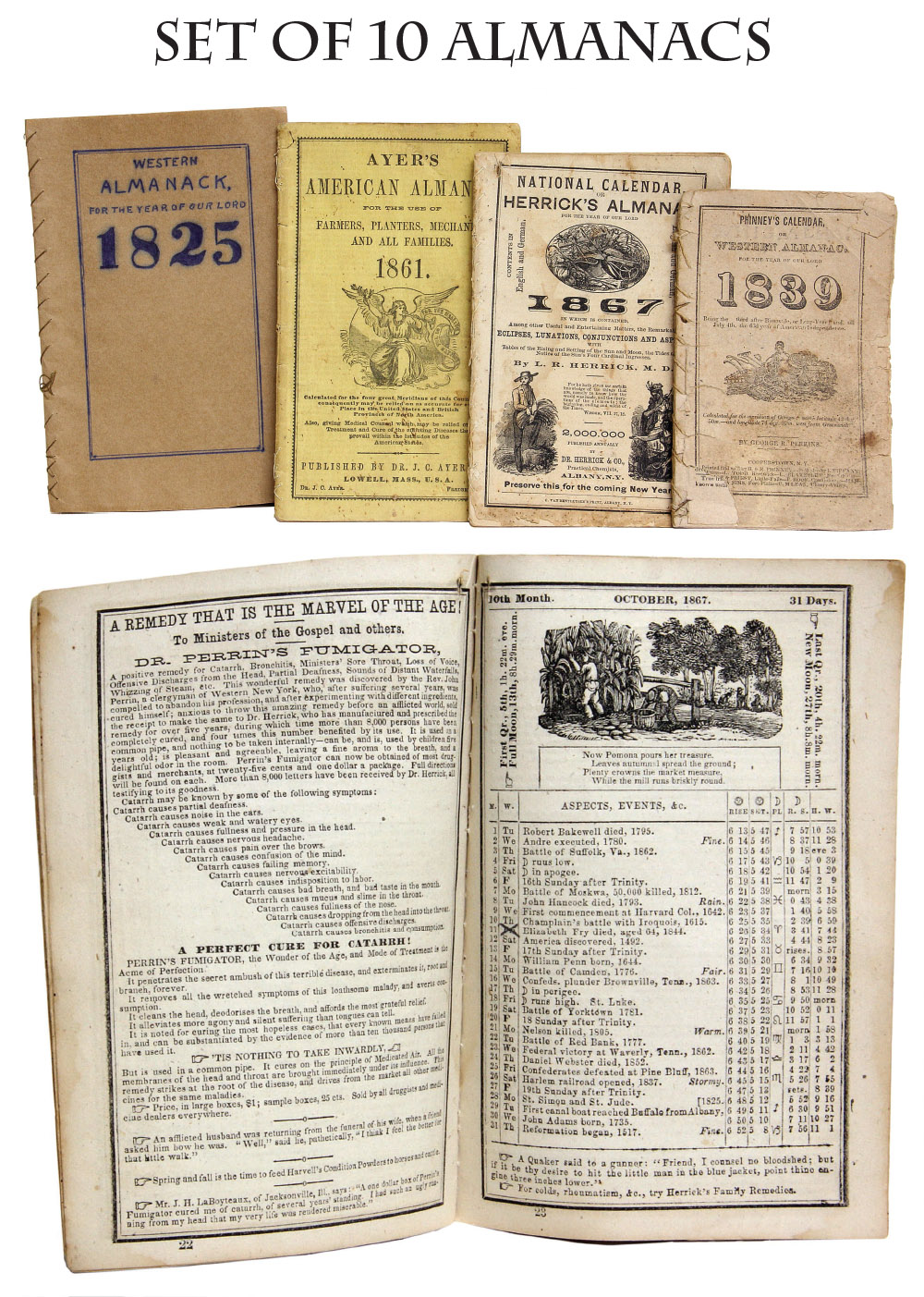
14-09-40 … 14-06-25 … Group of 10 Early Almanacs…
.. This group of 10 Almanacs (4 of them pictured above) range in size from 4″ x 6″ to 5″ x 8″ … Years included are 1813, 1822, 1825, 1835, 1839, 1860, 1861, 1865, 1867 and 1868 – Full of the standard almanac stuff, weather, crops, astronomical data, etc. Up through the late 20th century almanacs were essential. Now a smart phone is essential. All are completely original except for 1825 which a previous owner fashioned a new cover for. All ten for only
… $100.00 SOLD
Click Here to E-mail Us!
Call us @ 419-842-1863
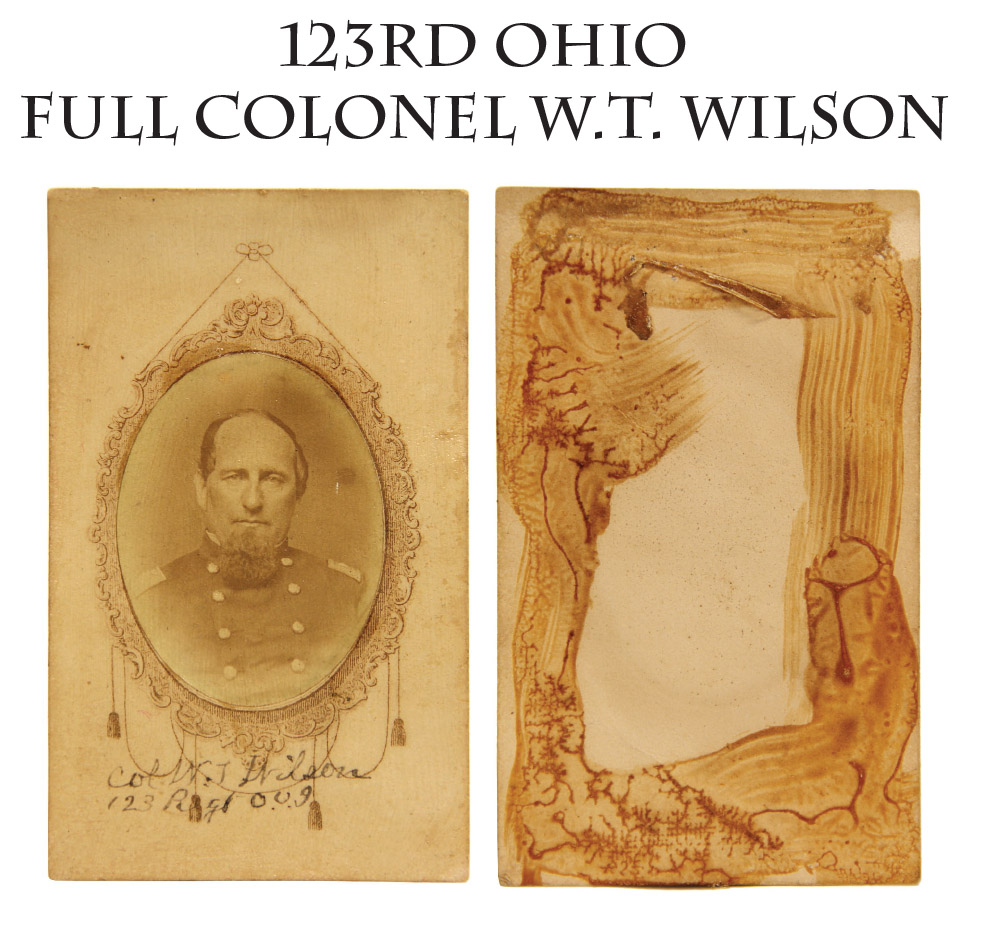
14-09-41 … 14-04-29 … Rare Subject ; Brevet Brigadier General William Tecumseh Wilson 15th and 123rd Ohio Infantry:
Vignetted oval bust view in a field-grade officer’s coat mounted on a cdv card with a printed hanging frame to mimic a portrait hung on a wall. Tones a tad light, but clear. Reverse shows glue marks from mounting in an album. Old ink identification bottom front: “Col. W. T. Wilson / 123 Regt O.V.I.” Wilson is a tough Ohio colonel and brigadier general to find in an original 1860s photo. Born in 1823 in Pennsylvania, he apprenticed as a printer and eventually rose to be newspaper publisher and editor. During the Mexican War in enlisted in the Pennsylvania volunteers and participated in the sieges at Vera Cruz and Puebla, and the capture of Mexico City, rocketing up to the rank of fourth corporal by the time of his discharge in 1848. Thereafter he published newspapers in Hollidaysburgh, Pennsylvania, and then in Blair County, Ohio. When war broke out, he enlisted at age 35 on 4/23/61 and was commissioned Captain of Co. C 15th Ohio Volunteer Militia on 4/27/61. This was one of the first Ohio regiments, enrolled for three-month’s service, and was sent to West Virginia. There they did guard duty, but also served on a number of expeditions and took part in the actions at Philippi, Laurel Hill and Carrick’s Ford. After the regiment was mustered out, Wilson was promoted on 8/6/61 to Lt. Colonel of the 15th Ohio Volunteers, a three-year outfit assigned to the Army of the Ohio, which first saw action at Shiloh in April, 1862, losing 6 killed and 62 wounded under command of the regiment’s major. Wilson must have been well regarded, however, he was discharged from the 15th OVI on 9/26/62 for promotion to Colonel of the 123rd Ohio on 9/26/62, which again placed him in western Virginia. The regiment’s first real action was during Lee’s advance north in the Gettysburg campaign when they fought General Early at Winchester, losing some 100 men before being compelled to surrender the next day, 6/15/63, with the rest of the brigade. Wilson was confined at Macon and at Columbia, before being paroled 3/18/64 and officially exchanged 5/28/64. The regiment saw more action at Lynchburg, Snicker’s Ferry, Winchester, Berryville and other locations, facing off against Early several more times. Only at Opequon, Fisher’s Hill and Cedar Creek did they begin to taste victory and thereafter went to Bermuda Hundred and the siege of Petersburg, where they eventually gained credit for capturing two enemy flags. It was irony that their last action was the Battle of High Bridge in the pursuit of Lee, where they were hit from the rear by Confederate cavalry and once again became prisoners of war. Wilson mustered out with the regiment on 6/12/65. During their service they had suffered heavily, losing 91 officers and men killed or mortally wounded. Wilson served as Comptroller of the Treasury in Ohio and also as mayor of Upper Sandusky. He died at Columbus, Ohio, in 1905. Extremely scarce subject
… $195.00
Click Here to E-mail Us!
Call us @ 419-842-1863

14-09-42 … 14-06-54 … Package for 58 Caliber Musket:
Here is a very affordable display package. Just the wrapper, no cartridges – a St. Louis Arsenal 1864. Label has wood-cut showing sectioned minie bullet and wording. “Rifle,Musket and Rifle .58 / 65 Grains Powder /
minie ball image
/ St. Louis Arsenal / 1864”. Four packages of these were issued to each infantryman so he could fill his cartridge box with the well known “40 rounds”. Background image (as an example only) shows an original St. Louis arsenal crate that would have contained 100 packs of these cartridges. A nice value at
… $275.00 SOLD
Click Here to E-mail Us!
Call us @ 419-842-1863
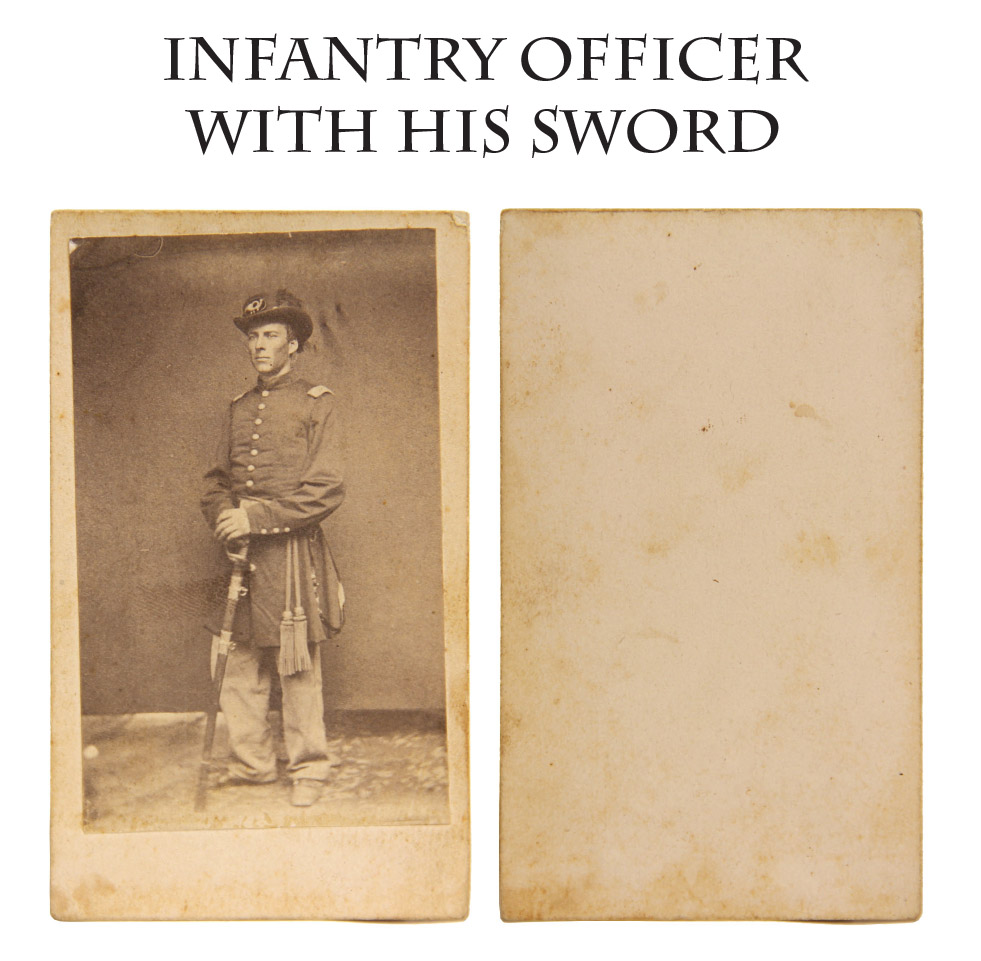
14-09-43 … 14-04-30 … Likely an Ohio Infantry Line Officer:
A nice CDV of an infantry line officer with some character. Typical of the young men who led companies into battle. This officer wears a plumed slouch hat with an embroidered infantry officer’s hunting horn on the front and holds his foot officer’s sword in its scabbard to the front with his hands on the pommel at “parade rest.” His frock coat is single breasted, showing him to be a captain or lieutenant. I think I see a single bar on the forward part of his shoulder strap, which would make him First Lieutenant. In any case, he was one of the line officers who mixed with their men on a daily basis and led them on the firing line. He was proud of his officer’s sword, to show it off to the camera he had to unhook it from its sword slings, which hang from his officer’s waistbelt. Part of his belt plate shows above his clasped hands, and his officer’s sash hangs down, the tassels showing at the left knee of his light colored trousers. This is a studio shot with a plain backdrop, but the rug shows a pattern. I can’t help noticing that rather than a fancy pair of boots he has adopted a comfortable pair of shoes for the long marches trudging beside his men. No backmark, When I was a teenager I found a CDV album here in NW Ohio that contained another identical CDV to the one here shown. As I recall that one bore a poem… “Remember me when this you see Though a thousand miles between us be.” I don’t know who this man is but I’ll bet he served from Ohio or Michigan. Neat view
… $95.00 SOLD
Click Here to E-mail Us!
Call us @ 419-842-1863
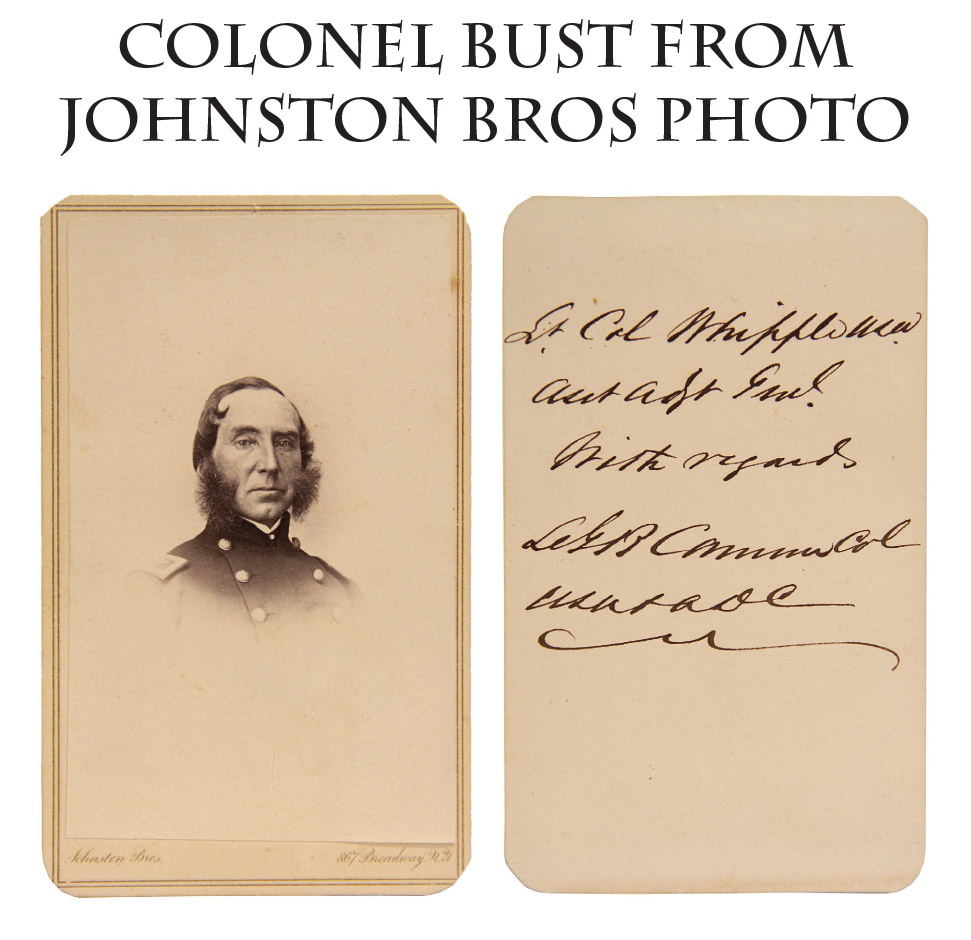
14-09-44 … 14-04-31 … Special Aide to Lincoln / African American Related / Signed CDV of Colonel Le Grand Bouton Cannon, Aide-de-Camp to General Wool, influential in the Union Defense Committee in 1861,
the sheltering of escaped slaves at Fortress Monroe, the enlisting of black troops in the army, and internal army politics. Crisp vignetted bust view of a field-grade officer with flashy sideburns! Cannon was from New York and had served as a volunteer on General Wool’s staff before the Civil War. When most of Wool’s staff resigned and went south, Cannon and a few other prominent New Yorkers joined his staff as volunteers, Cannon acting a volunteer ADC to Wool from April 23 to August 28, 1861. During this period he took an active part in the Union Defense Committee of New York in corresponding with and aiding various northern governors, like the Governor of Illinois, who were trying to obtain arms, etc., and organize without adequate leadership from Washington.
Cannon was officially appointed Major and AADC on Wool’s staff August 28; and Colonel on Feb. 1, 1862. He accompanied Wool to Fortress Monroe, Virginia, which they preserved for the Union. Cannon was involved in formulating the “contraband” policy about escaped slaves who had sought protection at Fortress Monroe and was intimately involved in some of the army’s political infighting. His reminiscences published after the war include a number of first hand accounts of the Monitor and the Merrimac, time spent as a special aide to Lincoln, and experiences with Secretary Stanton, etc. Cannon resigned June 11, 1862, but rejoined Wool’s staff as a volunteer for a time thereafter, until Wool’s retirement in 1863. Cannon’s accounts are a real insider’s view of the doings at various army headquarters. He had been offered the military command of Norfolk, before resigning.
The card is presented to Lt. Col. Whipple, who is probably William Dennison Whipple, West Point class of 1847, who served until 1890, was both ADC and AAG at different points in his career, served on Gen. Hunter’s staff, the staff of General Thomas, and after the war as ADC to Sherman from 1873 to 1878: “Lt. Col. Whipple USA / Asst Adjt Genl / With regards / Le GB Cannon Col / USA & ADC.” Their staff duties had probably brought them into connection at some point, though Whipple was a New Yorker like Cannon.
A significant subject involved in some important early war doings
… $195.00
Click Here to E-mail Us!
Call us @ 419-842-1863
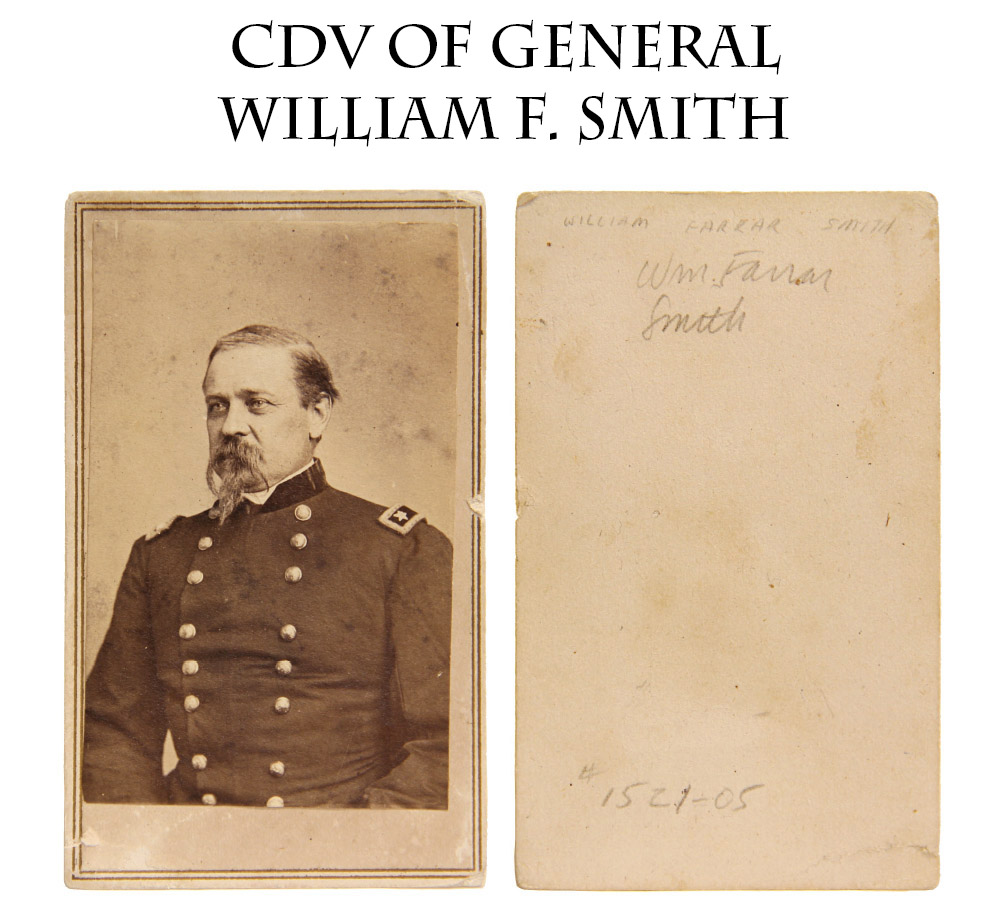
14-09-45 … 14-04-33 … General William F. Smith—He spoke his mind!
Wonderful half-length seated view of the outspoken general in his major-general’s frock coat. Couple minor abrasions to card edge, otherwise excellent. “Baldy Smith” was West Point class of 1845, an officer of engineers until the Civil War, and Colonel of the 3rd Vermont in 1861 serving on the staff of General McDowell at Bull Run. He became a Brigadier General of Volunteers in 1861 and led a division of the 6th Corps on the Peninsula and the Maryland Campaign, and commanded the corps at Fredericksburg. Critical of Burnside and a supporter of McClellan, he was shunted aside in 1863 and sent west, where he ended up feuding with Rosecrans but earning some praise from Grant, and made Major General in 1864. Brought east to command the 18th Corps under Butler, he criticized both Butler and eventually Meade. Accusations that he could have acted more aggressively at Petersburg led to his removal from command in July, 1864. He left the army in 1867, turning to civil engineering and acting as president of a telegraph company and the NY Board of Police Commissioners until his death in 1903. My favorite quote of his was his judgment on Butler: “as helpless as a child on the field of battle and as visionary as an opium eater in council.” He cerrtainly knew how to craft a criticism
… $125.00
Click Here to E-mail Us!
Call us @ 419-842-1863

14-09-46 … 14-04-27 … US Hospital Library Marked – 37th Illinois Identified Tract Book:
1827 dated volume of Sir Walter Scott’s “Waverly or Tis Sixty Years Since” (one of four volumes that comprised that work), part of the “Pocket Library of English Classics.” Pasted to the cover is a printed paper label reading “For the use of invalid U.S. Soldiers, at New Orleans,” with the handwritten addition in ink “library.” Given the publication date, this could have been a charitable donation to a Mexican War era military hospital in that city, but is more likely a Civil War contribution to the hospital service. This is backed up by the period pencil identification on the flyleaf reading:
“Mr. Daniel D. Cooper / Belvidere/ Illinois / Co I 37th Regt. Ill Vol.” Cooper is listed in CWData as a resident of Belvidere who enlisted at age 24 on 9/1/61 as a private and mustered into Co. I 37th Illinois on 9/18/61. He re-enlisted as a veteran on 2/10/64 and was wounded severely in the left arm at Fort Blakely, Alabama, on April 9, 1865. This resulted in the amputation of his arm and his discharge for wounds on 5/24/65. He died in 1897 and was buried in Garden Prairie, Illinois. Note the photo of him found on the internet. I wonder if he was blinded in one eye as well? The 37th is a very interesting unit and there is far too much recorded in their history to more than summarize here. The unit was nicknamed the “Fremont Rifles” and saw very active service in Missouri, Tennessee, Mississippi, Louisiana, Arkansas and later Texas (after Cooper’s wounding.) Under Fremont it took part in the capture of Springfield, Mo., and then served under Curtis and Herron, being part of the Army of the Frontier, Department of the Tennessee, the Army and Department of the Gulf, and the 13th and 19th Corps at different points. They took part in major engagements such as Pea Ridge and Prairie Grove, and were involved in the siege of Vicksburg, but also took part in numerous skirmishes and expeditions against Confederate guerrillas in Missouri and raiding forces elsewhere, earning the second nickname of the “Illinois Greyhounds” for their numerous and rapid marches. By the end of their service they had covered more than 3,000 miles on foot and another 14,000 by ship and rail. They lost 4 officers and 60 enlistedmen killed in action or mortally wounded.
The book is in somewhat delicate condition, with some tears and separations, but it displays very well and is a good candidate for a medical display but also for someone interested in the 37th Illinois and the western campaigns. It is also a reminder that the war did not end with Appomattox and a telling memento of a soldier who almost made it through unscathed, but suffered a crippling wound the same day Gen. Lee was surrendering
… $195.00
SOLD
Click Here to E-mail Us!
Call us @ 419-842-1863
Layaways are Welcome
Need to split your order into multiple payments? No problem! A simple 20% earnest money deposit will hold your item for you.-acf
You can then pay it off in easy installments that fit your budget.
Read Terms Here
Items to Sell? Contact Us
I am always interested in buying ANYTHING from the American Civil War… Guns, Swords, Civil War Muskets, Knives, Uniforms, Flags, Medals, Badges, Diaries, Letters, Autographs, Buttons, photographs, tintypes, daguerreotypes, Insignia, Camp Items, Battlefield Relics, canteens, Drums, Etc… Call 419-842-1863 and ask for Dave Taylor.

